I’m creating this helpful guide because I’ve had trouble losing money in Cities: Skyline 2, and I want to share my knowledge to make it easy for everyone to understand. This guide will teach you how to make money in the game, explain how money works in detail, and provide tips on avoiding financial losses.
مقدمة
The reason I’m making this guide is that I’ve struggled with losing money in my cities, and I want to share my experiences to help others. Once you grasp these concepts, the game will become much simpler.
Keep in mind that this guide was created based on version 1.0.11f1 of the game. If the guide becomes outdated, I’ll update it to match the latest changes. لكن, the advice given here should remain relevant for various economies, updates, and maps.
Feel free to skip ahead to specific sections if you’re confident in certain aspects of the game. But I recommend at least skimming through the guide to catch the essential tips and information.
ابدء
This guide is versatile and can be applied to any map you choose in Cities: Skyline 2. Let’s begin by focusing on the Sweeping Plains map, which I believe is one of the most challenging maps due to its unique characteristics. This map has a large landmass with many mountains, limiting the available building space to less than a third of the map. It also has limited rivers and water access, making shipping a challenge. بالإضافة إلى ذلك, it’s not very fertile, which can be crucial for your city’s development. If you want an easier experience, consider maps like Barrier Island or Great Highlands.

For this playthrough, I’ll enable disasters and choose Left-Hand Traffic. The road layout on the left side may not impact your economy significantly but can affect your road design in minor ways. Natural Disasters being enabled will make the game more challenging, but you can turn them off for an easier experience. لكن, they rarely affect my games, so I prefer to keep them on. The theme you choose for your city doesn’t matter much, as you can change it later when zoning.
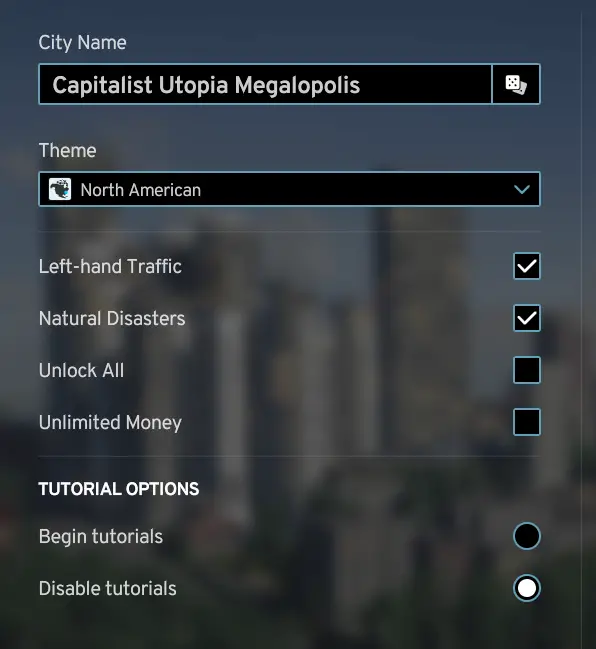
الآن, when you first load the game, there are three critical things to consider:
- Natural Conditions: Take a good look at the map’s geography, wind direction, water sources, and the landmass surrounding your city. These factors will play a crucial role in your city’s development.
- Connections, Utilities, and Outside Links: Plan how your city will connect to the outside world, consider utility placement, and ensure access to essential resources.
- Basic Zoning: Start planning your initial Residential, Industrial, and Commercial zones. Keep in mind that this zoning is likely temporary or will be partially demolished as your city grows, so don’t spend too much time on it. والأهم من ذلك, make sure to pause the game when you’re in this initial planning stage to avoid any surprises.
Natural Conditions
Let’s take a closer look at the information provided here. I’ve used the electricity view panel and a wind turbine to identify the direction of the wind, which is crucial for our city’s development. In the top right area of our buildable space, we can see a strong wind pattern, making it an excellent location for a wind farm.

Wind power is my preferred choice for early energy generation. It’s cost-effective and works well for smaller populations. As our city grows, we’ll explore other energy sources. An advantage of wind power is that it doesn’t require imports, making our economy more stable and efficient in the long run.
You can also use the water tab to check the flow of water, but we’ll discuss that later.
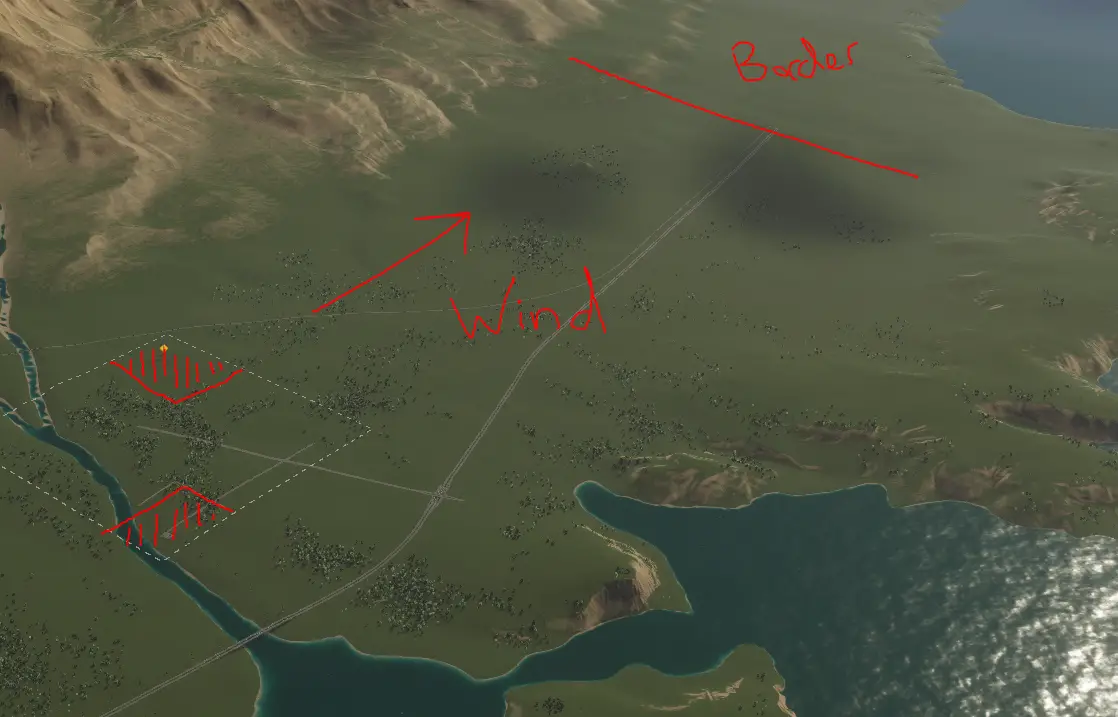
In the image above, I’ve created a preliminary plan, taking into account that the wind will push air pollution toward the border. In the top marked square, I intend to build industry, while the bottom square will house garbage and other low-pollution services. You can use gravel roads in the game to create inexpensive visual markers to plan your city’s layout.
It’s important to note that I’ve already decided these industries will be temporary. A significant portion of buildable land lies between my starting area and the border, which I’ll eventually own and develop. There’s also a nearby train line, making it an ideal location to build a train station early on, which will greatly reduce the cost of importing and exporting goods. Train and sea routes are cost-effective ways to transport large amounts of cargo. Sea routes require more planning, while you can easily extend rail lines where needed, leading us to our next section.
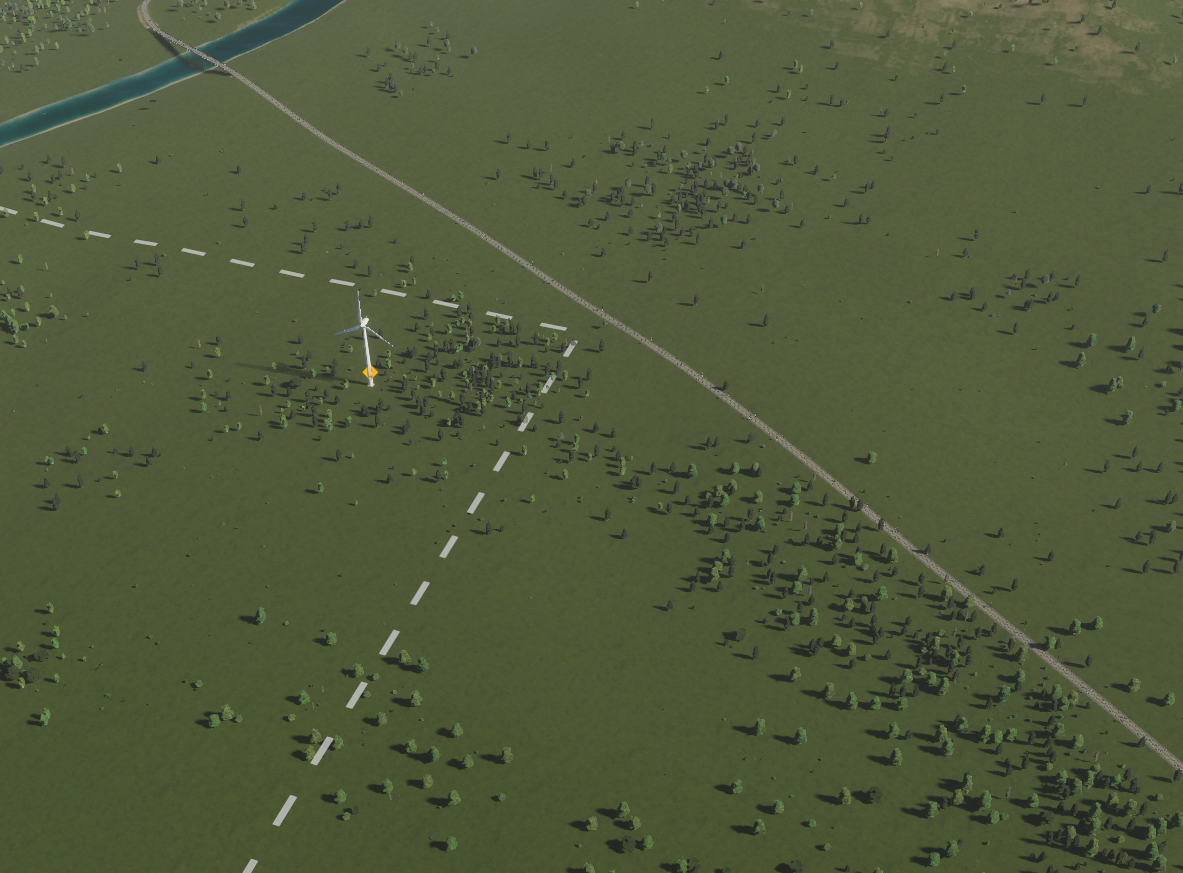
Connections
Connecting your power supply to the international grid should be one of your top priorities. This step is super important because it not only prevents blackouts but also allows you to sell any extra power you generate for a profit! $$$

A key tip here is to bury your power lines. You can use Page Down or the button circled in the image below to do this. It’s a bit more expensive, but it saves you from having to work around them later. For all your utilities, including the big power lines, keep them underground. The stats you see related to battery charge and excess production in the image seem to be from my own game and aren’t relevant, so you can ignore them.

Water and sewage are a bit different. You’ll have to provide these services yourself, and you can only trade them by creating an outside connection with sewage and water pipes leading out of the city. Before you plan too much, check for underground water sources. While not the most cost-effective option, this information will be handy later when considering geothermal power. It’s best not to use groundwater, especially if it’s close to your industrial area, as it can lead to ground pollution in addition to air pollution.
In the updated plan below, you can see I’m using gravel roads to mark and keep track of things. I’m avoiding building over the underwater pools for now, as they might come in handy later. لكن, the one near the industrial area is a bit risky, and I might change that plan later. I’ve also marked the water flow in the river. Remember to place sewage and water pumps at different ends of the water source. Upstream, where the river flows from, you should get your water, and downstream, you can dispose of sewage, and it will flow out to the sea. لحسن الحظ, there are no environmental regulations in the game that frown upon this!
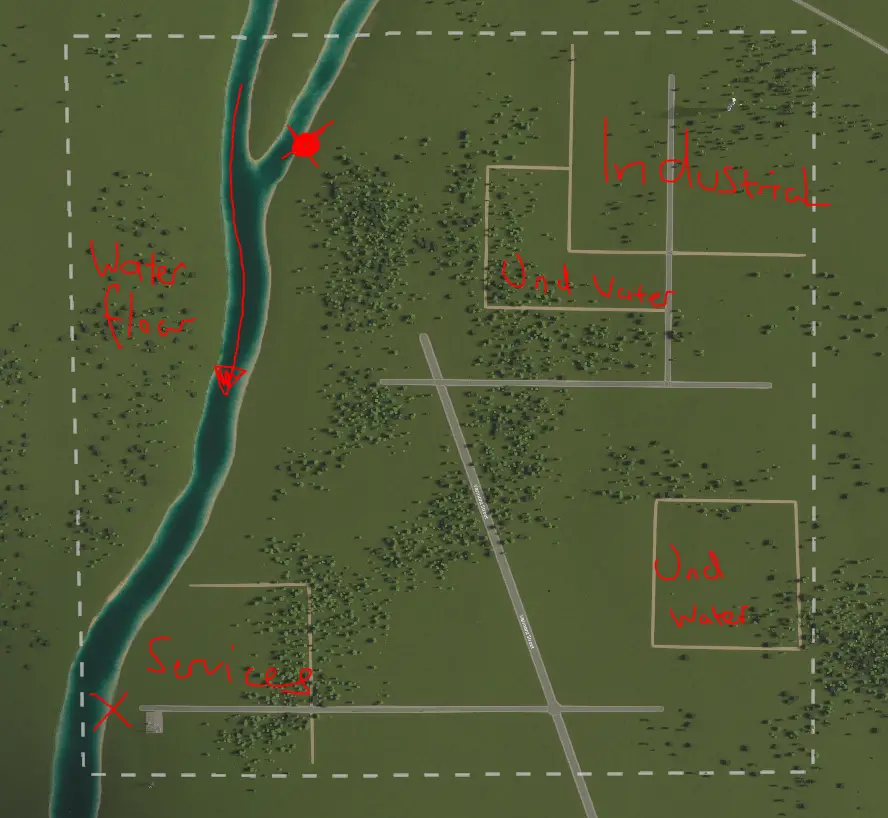
I’ve marked sewage with an X and water with a dot that has an X in it. With power, sewage, and water in the right places and the grid connected, we have a solid foundation to move on to the next stage.
City Planning
Lesson 1 in City Planning
Road Hierarchy, road types have meaning, place them correctly and you’ll have very few traffic problems.
Highways:
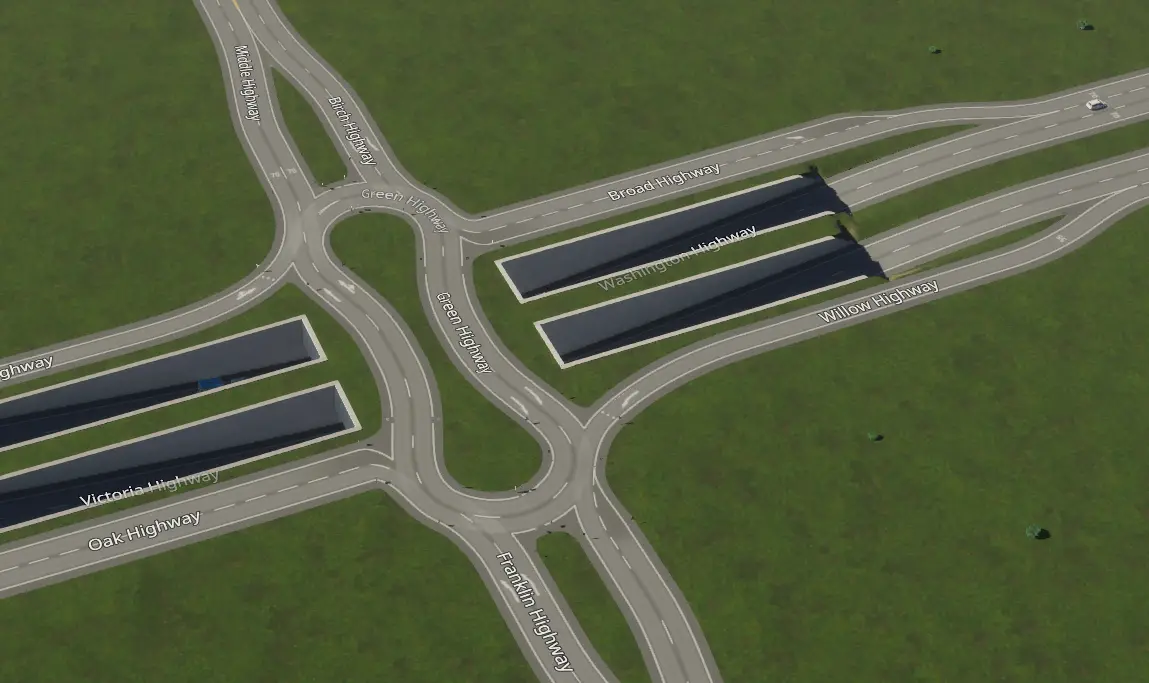
Highways are to get out of the city or into the city, they move the most traffic at the fastest speeds, if traffic intends to leave the city from one place it needs a highway there.
Arterials:

Arterials are main roads and come off of highways to “pump” traffic through the city, they also will feature your largest connections within a district. Buildings can be zoned on arterials but the majority of a collectors job is through-traffic. Traffic wants to travel through an arterial to get to its destination, most destinations won’t be here. Yes the word comes from Artery, and like your heart they are the main channels that blood (or in our case traffic) will flow.
Collectors:
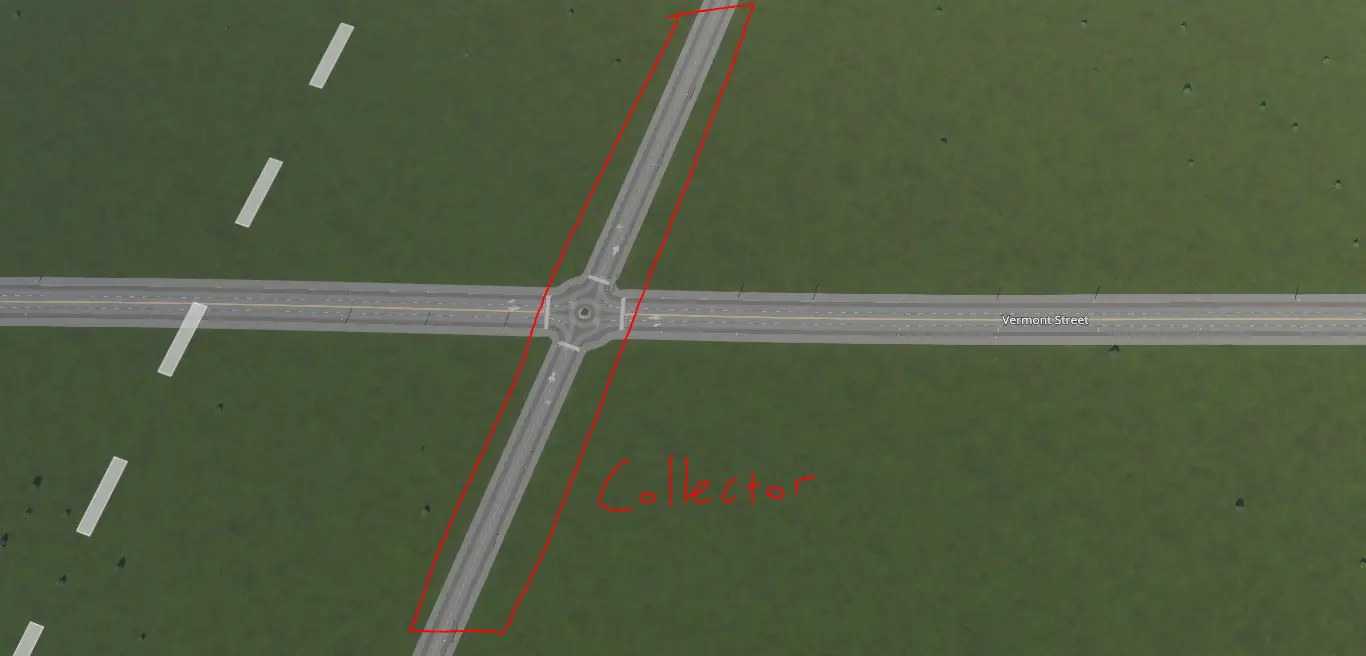
Collectors are the key roads in your city, where most services and buildings are located. Collectors come in various forms, such as small roads, alleys, and even pedestrian streets. The majority of people will live on collectors, work on collectors, and use collectors to arrive and depart. Consequently, most of your zoning will happen on collectors.
Why is this important? Understanding this is crucial for planning your city’s road network, both for the present and the future. Traffic issues can lead to economic problems, and a city with traffic troubles can’t sustain itself, support its residents, or handle crises effectively. To avoid future issues, you need to establish a strong foundation. This explanation might not cover road hierarchy perfectly, but it conveys the fundamental concept.
As shown in the image below, this is how I typically plan my road network in districts. An artery of four-lane roads serves as the main thoroughfare, with two-lane roads functioning as collectors and pedestrian streets serving as sub-collectors. This hierarchy helps maintain a well-organized city layout.
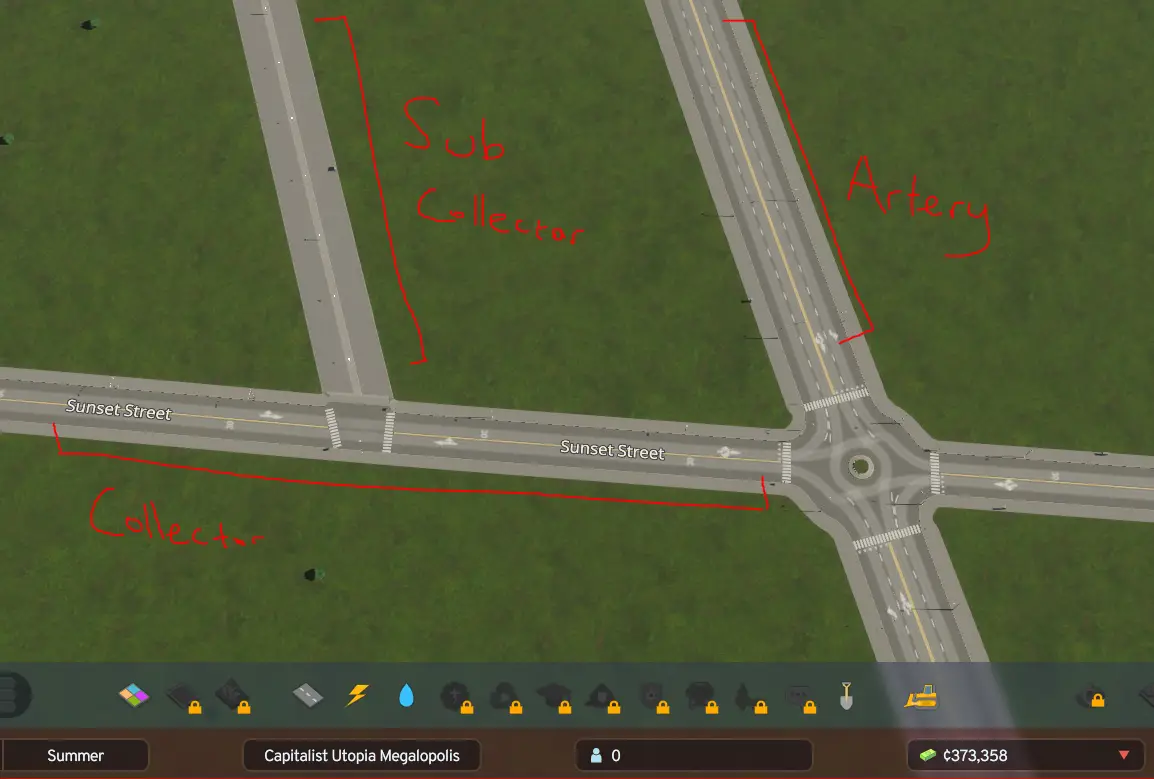
Also don’t forget in cases like the image below we can sacrifice a small amount of space to facilitate pedestrians. We want the least amount of people driving as possible and offer people the ability to walk or bike where they need to go.
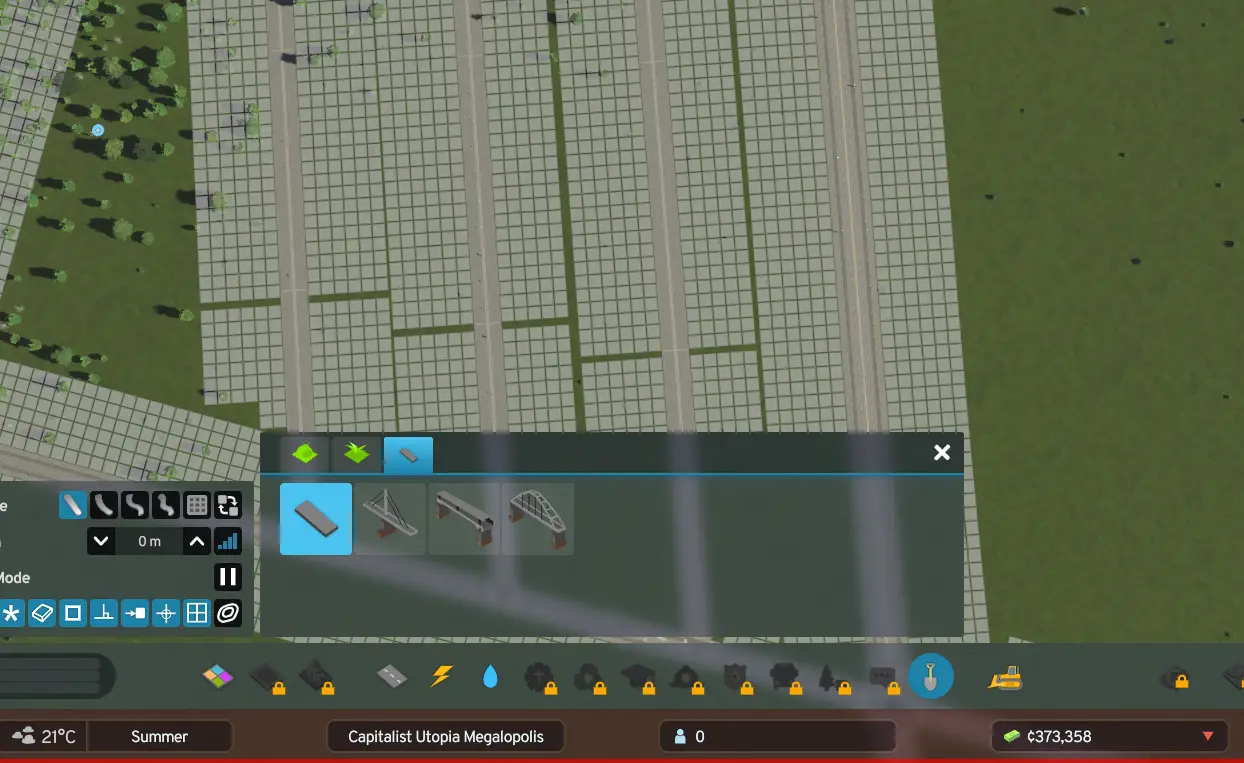
People who walk instead of drive makes traffic flow on the streets better for those who need to drive like trucks, long travellers and services. People who walk also may not have the wealth to afford a car and we don’t want as many people in our population to be economically productive citizens.
Zoning
Zoning is important because we also want to make the journey between residential and commercial as short as possible. You might think to segregate commercial and residential but this is not a smart idea, it will lead to a lot of traffic focused on a small area of your road network. Take the following layout for example:

Residential in between commercial zones, most of which face collectors rather than the arterial, this will mean most people in this neighbourhood will have their needs met on their very own street! Most will either work here or in the industrial district across town which will manage for now on mostly traffic connections…
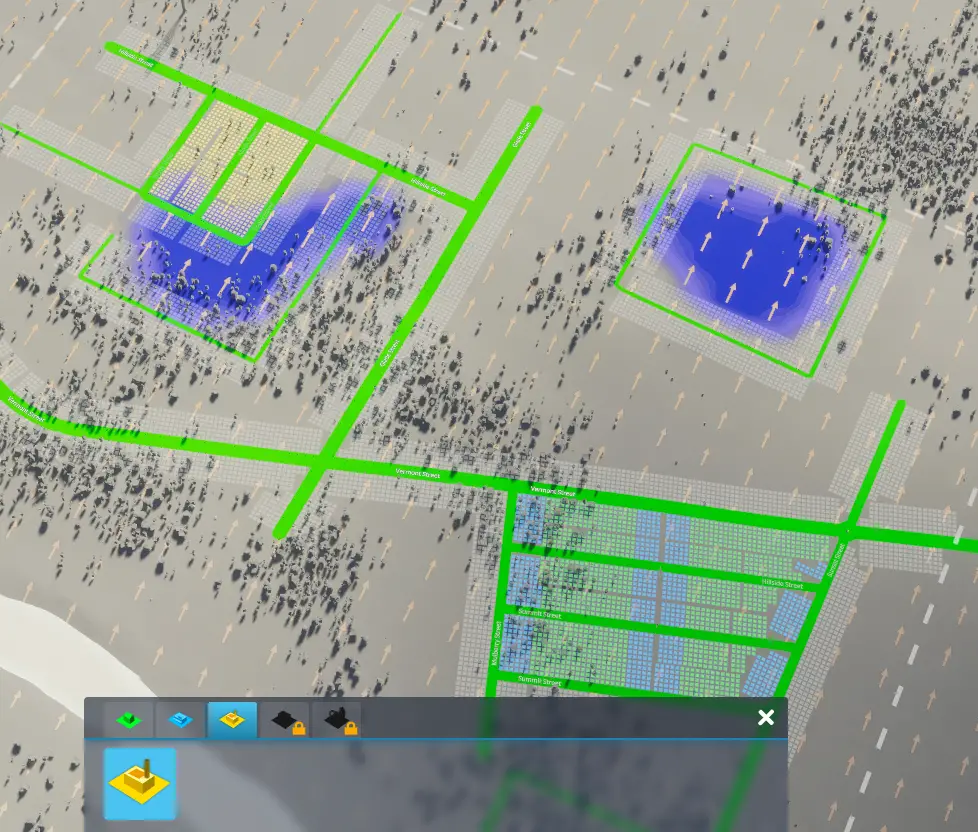
In the image, you can observe that I’ve designed the arterial roads to lead into the industrial area, with small collectors for the industries themselves. This layout should help handle the higher traffic demands. بالإضافة إلى ذلك, I plan to expand the industrial area to the other side of the arterial road in the future.
With this setup, you’re now ready to press play and let the simulation run. Keep in mind that in the beginning, you may experience a temporary financial loss before your city starts generating a profit. This is a normal part of city building, and as your city grows, you’ll see your efforts pay off. Good luck with your city-building adventure!
Expanding your City
Breaking from Traditions
Just because I said you shouldn’t segregate your zoning doesn’t mean it isn’t something that will or even should happen. For instance already I’m breaking from traditions in my first expansion right after the planning and moving in stage began:

Breaking the rules in city planning should always have a good reason, and in my case, it’s the services area near my starting village. This area will have some level of pollution, and I don’t want to zone homes right next to it. While the residents will work there, I want to ensure they don’t have to breathe in dust and fumes from sewage outlets and welding machines while they’re at home, trying to relax and enjoy their meals.
It’s essential to remember that demand for different zones is asymmetrical. You’ll generally need more residential areas than any other type. Experimentation is key when determining the exact numbers. While I can’t provide precise figures, the fun lies in experimenting and not letting the quest for perfection hinder your progress. The grid is a fantastic tool for city planning, but don’t be afraid to break away from it; you’ll find more enjoyment in experimenting and creating unique layouts for your city.
Listen to your people
Chirper is actually a useful tool to see if people have some concerns that you’re missing. For instance someone is already complaining about the noise in the city. But no one has even liked them so this is problem something that only affects them.
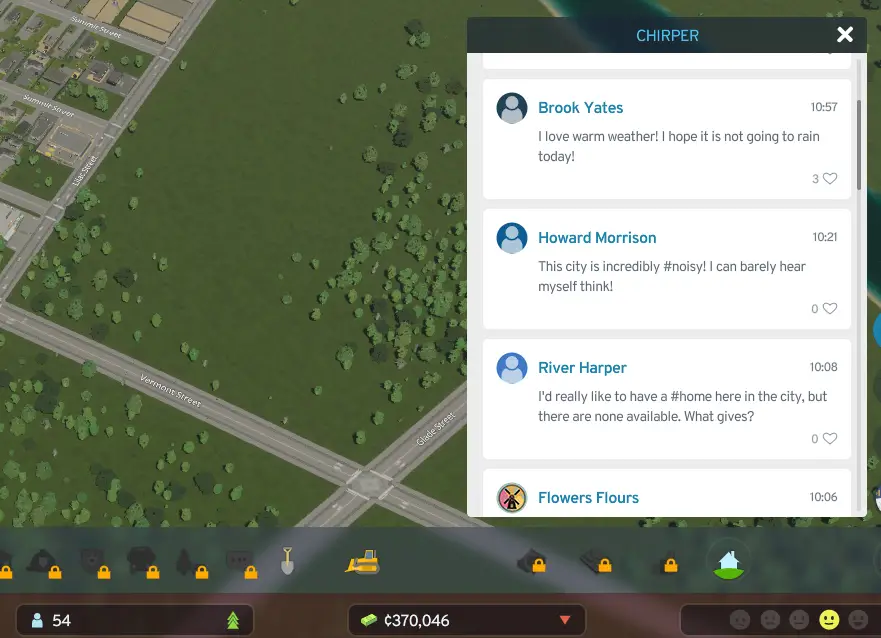
But you’ll find that sometimes large amounts of people will like a post complaining about something, look into it, there’s usually a reason. Though for Mr. Morrison he’s probably wishing he was in Hawaii right now he’s really only got a problem about noise in a commercial shop. Commercial buildings produce some noise, السيد. Morrison is just a rich entitled prick who I’m renaming to Scott Morrison as a reference to Australia’s former PM. We’ll see if he has any more banger Chirps later in the guide.

Once you hit your first milestone it’s time to start really getting into things…
Milestone 1 – Getting services running!
If your city is running smoothly without any issues, you can let it run in the background at 1 سرعة; this will help you generate more money in the long run. لكن, if you’re not making money yet, make sure to pause the game when making plans or decisions. By this point, you shouldn’t be making a profit, so go ahead and pause the game.
الآن, as for spending your development point, you only have one point to allocate, so your options are limited. I recommend starting with the Crematorium. Burying people in graveyards or using landfills for waste disposal takes up valuable space, so having Crematoriums and Recycling Centers/Incinerators in operation early on is crucial.

You don’t need to build the crematorium right away; wait until people start passing away, as it’s a waste of money before then. لكن, what’s not a waste of money is investing in healthcare services to ensure the well-being of your citizens.
Build a Clinic now
Your citizens are not productive if they are sick and even less so when they’re dead, and until we figure out necromancy you’ll have to just give people effective healthcare.
Make sure to build it on a collector, in my case I built it in my services sector, though I plan to expand away from the clinic it’ll be more effective here since most people who suffer medical issues will live closer to the low pollution services area anyways.

Don’t be afraid to rezone old areas
Progress is quick, and you’ll have medium density rowhouses, more people near the services area means more people are closer to better services and more people live in better conditions.
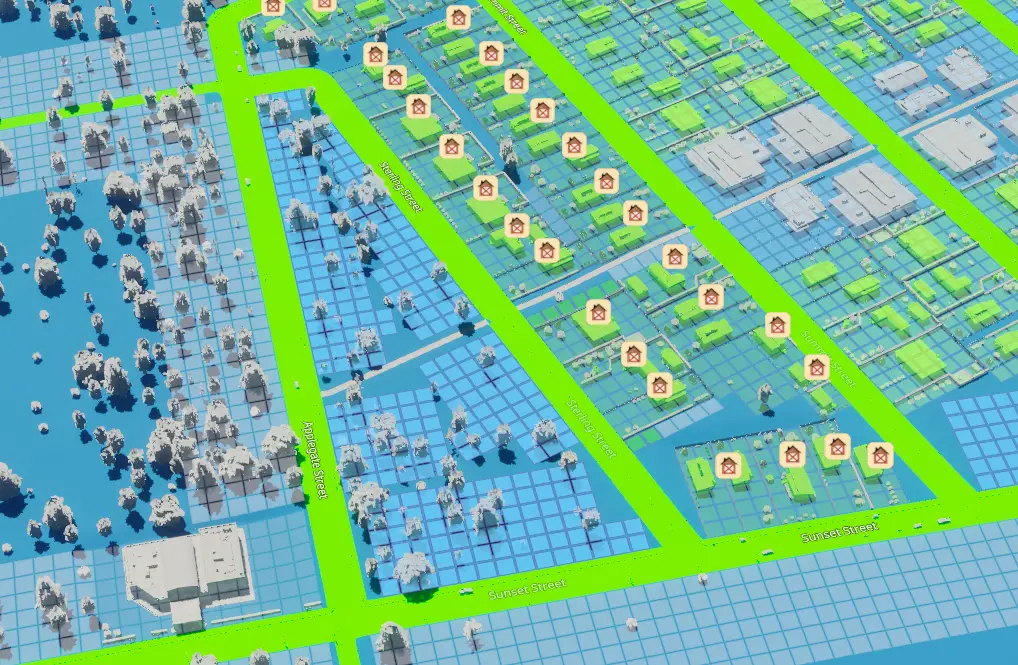
Don’t be a slave to demand
Progress also doesn’t mean catering to everyone’s demands, low-density residential is fine, but you can ignore it! Don’t be afraid to take away options especially if you want to make a rich city!
Also we’ll need to expand our city borders…
Expanding the City early on
If you don’t need more space, don’t buy it
Save your land permits if you don’t need them, in my current situation, I don’t need to buy more land, I still have room to grow and I want to buy my tiles more tactically. See the two red circles below are my planned expansion areas.

Don’t forget to periodically check on your power
You won’t be alerted when you lose power since the national grid will sell you power when you run a deficit. You want to sell cheap renewable power abroad, so make sure to expand when you lose excess power.

At this stage, your city will be operating on autopilot, gradually expanding and developing. You’ll soon start making money. If you’re not making a profit yet, it might be because you’re frequently pausing to write this guide.
كما ترون, if you turned the clinic off, your city would actually be in the black. لكن, you’ve decided to keep the clinic running, and you have nearly a million in the bank. The clinic is essential for providing healthcare to your citizens, and without it, you might run into problems early on. It’s a strategic choice to prioritize the well-being of your residents over immediate financial gains.


Scotty Update 1: A quick break up
I’m gonna break up this guide with random updates from Scott Morrison, I advise you also follow a few citizens, following them makes them post on Chirper more regularly and you can track and see their lives as they live in your city.
Scotty however is breaking up with Irene, good for him, Irene had no future anyways.

I’m going to follow Irene and see how she’s doing though, she might grow as a person from this, though she clearly got a good severance and job since she’s doing really well.

Signature Buildings!
As you play the game you’ll unlock signature buildings, you can also try and unlock them by looking at their unlock requirements but just let them come naturally at first.

Make sure to place them though!
They offer great benefits for your city, and a well-being bonus is good for keeping your people healthy and fit!
Don’t worry you can always move them later too.
Milestone 2 – Serious Considerations

This is where planning becomes serious!
We’re going to cover a lot in this section but most importantly is Taxation mechanics!
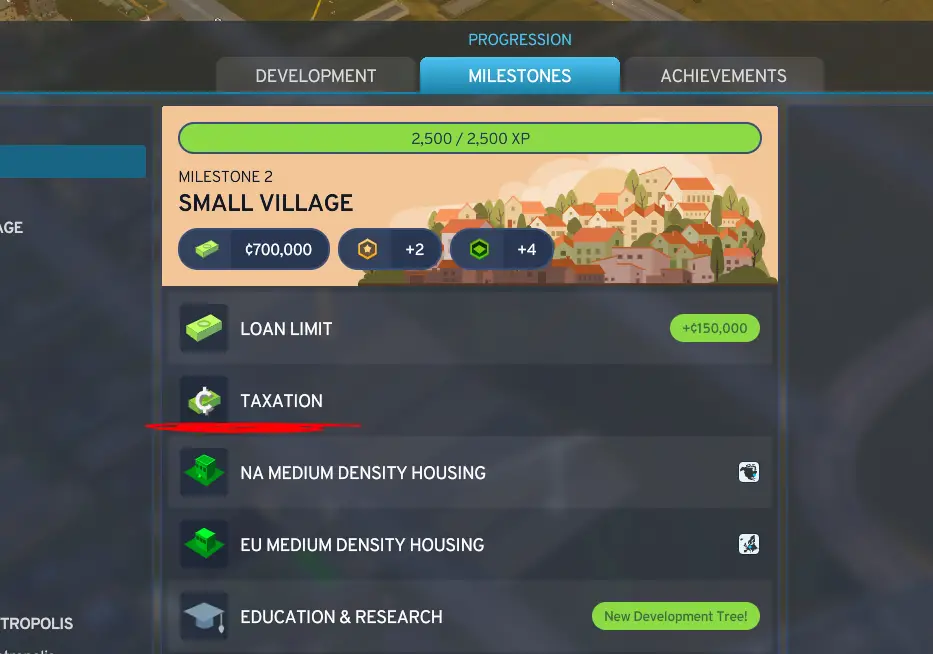
What we’ll be covering in this section:
- Taxation and Company Profits
- Education
- Sneaky Resource scouting
For now I spent my 2 dev points on the Recycling Center and got that down in the services sector of the town:
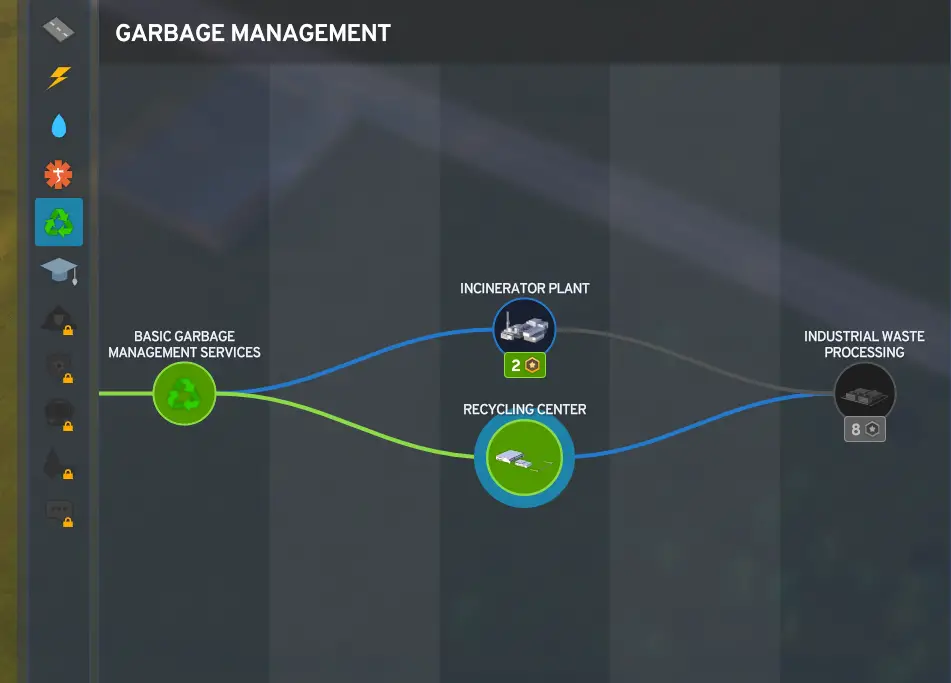
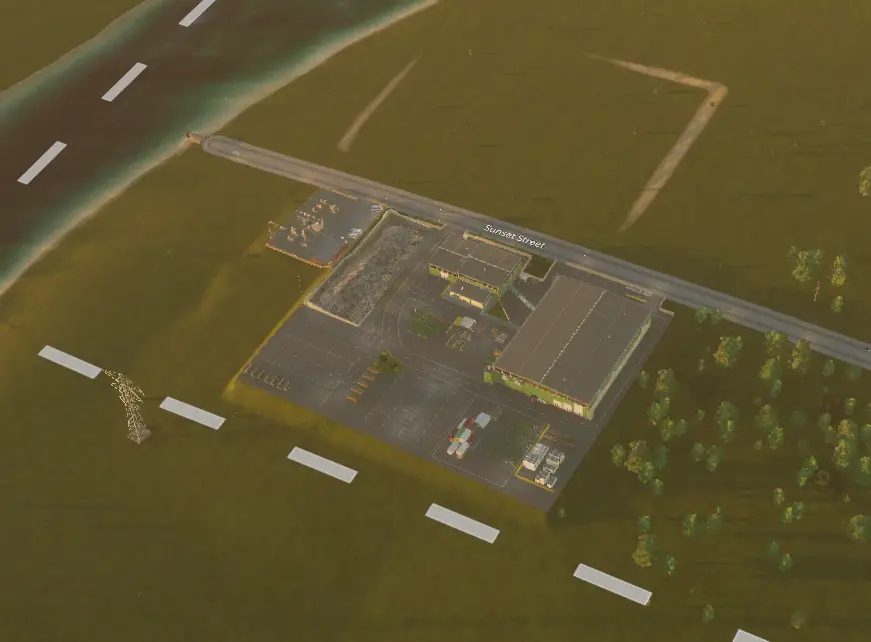
Taxation and Profit
Making money for the first time
Taxation once you know what you’re doing is relatively easy. There are a few tools we can use to make good decisions on our taxation.
أولاً, commercial is the most profitable industry by far, it is the point of sale of all goods and therefore will naturally always accommodate a higher profit margin.
You can use the “Company Profitability” view to best see how our industries are working on a general scale.
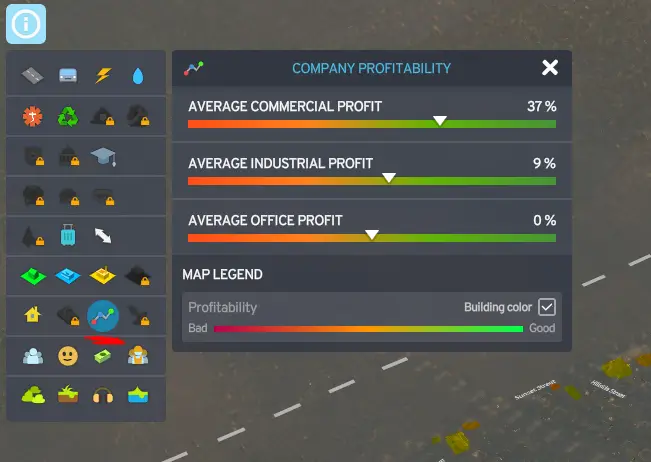
And yes by far the commercial sector is performing the best, so we can tax them the most. We’ll set our taxes later, we’ll get a good inference later on what our citizens wealth and income is like by checking the views: Citizen Wealth and Citizen Education
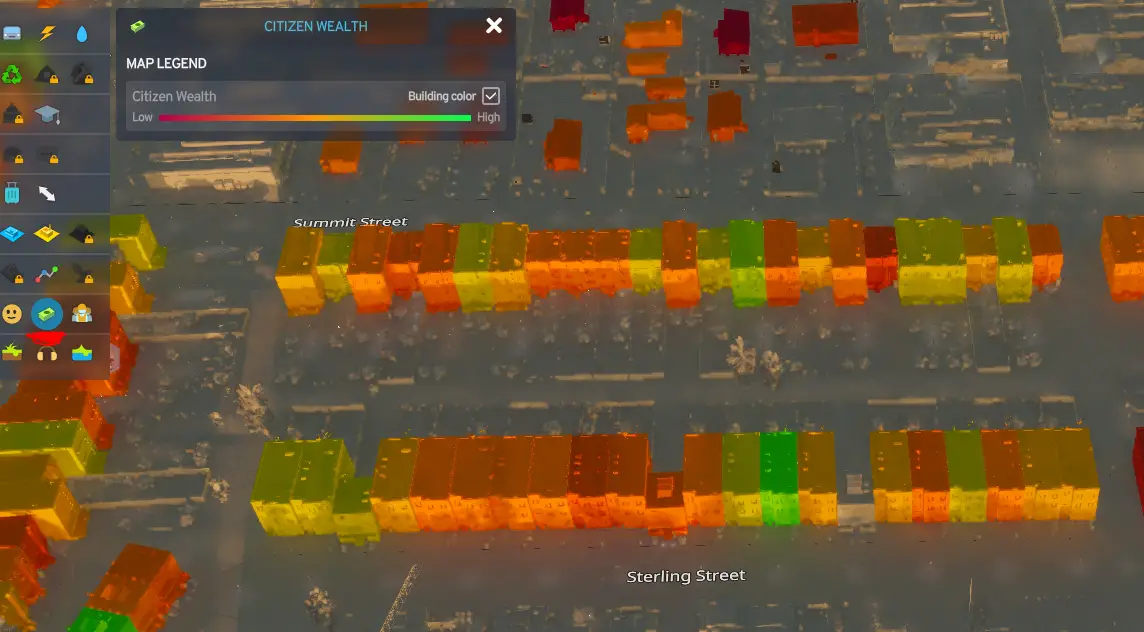
Note the home that is bright green in the above image and that white colourless building for reference of where it is.
In the below image it is also one of the richest buildings in the street too.
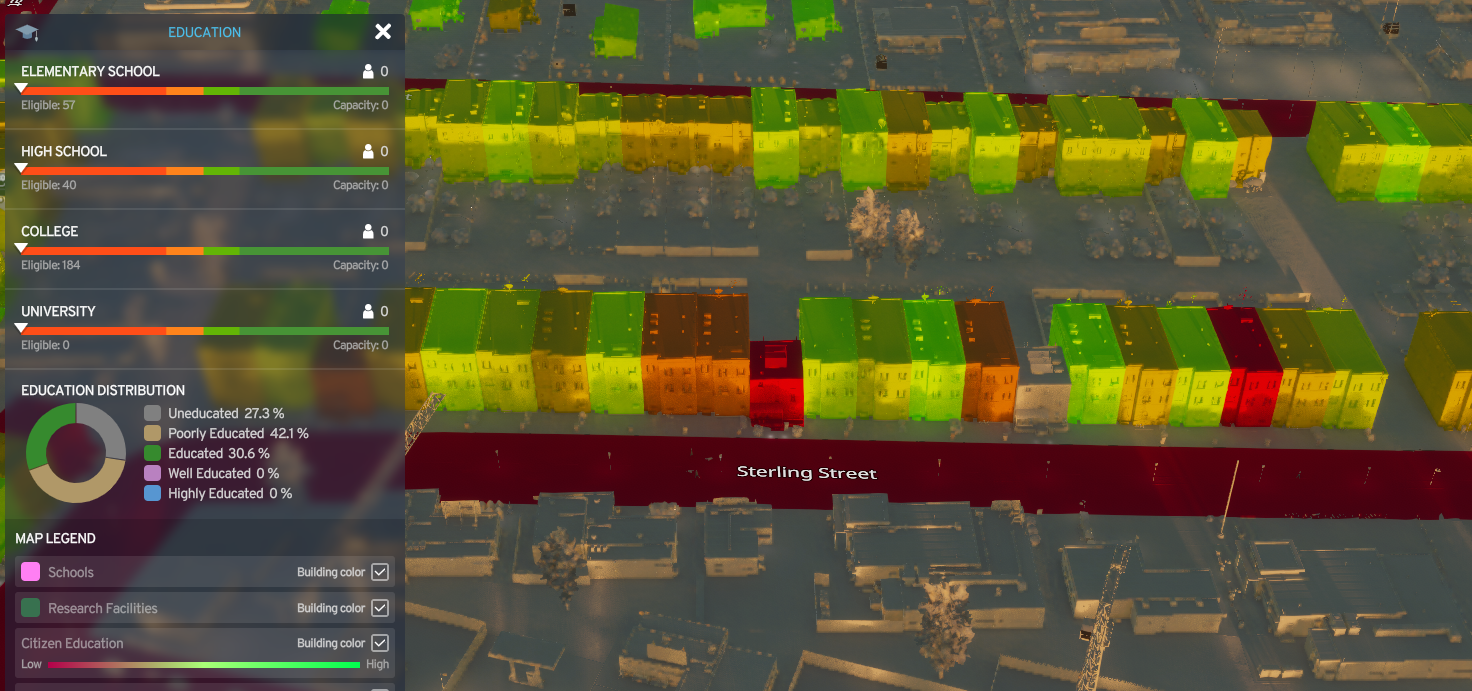
You’re absolutely right that education informs wealth but doesn’t solely determine it. When managing your city’s finances, it’s wise to progressively tax educated individuals more as their incomes and wealth increase.
Taxes will need to be adjusted as you play, periodically checking the wealth levels of your population. If you start to see a homeless population, it might not necessarily be a bad thing, which I’ll explain further later.
الآن, let’s discuss how to set your taxes. Based on the information gathered earlier, we can make the following inferences:
- Commercial Profits: If commercial businesses are generating profits of over 30%, it makes sense to tax them the most.
- Industrial Profits: Industrial businesses with profits under 10% should have their taxes reduced. This approach will make them more competitive in the market, leading to larger revenue and higher incomes in the long term.
- Educated Population: Taxing educated individuals more than their uneducated counterparts is a viable strategy, considering that educated people tend to have higher incomes and greater wealth.
Adjusting your tax rates according to these principles can help optimize your city’s revenue and maintain a balanced budget.

Your approach to taxation is quite sound. Taking the profitability of an industry and taxing it by about two-thirds of that amount provides a reasonable starting point. Fine-tuning the tax rates based on any large profit spikes or crashes is a smart way to ensure your city’s financial stability.
In your case, you’ve rounded down to 20% for commercial taxes and are taxing industrial profits by precisely two-thirds, which comes to 6%. For individuals, you’re using a range of 10-14% income tax at increments of 2% for each education level. While it’s not an exact science, it’s important to remember that economics is not a perfect science, and economists don’t always get things right.
As you continue to develop your city, you may eventually prioritize growth. But for now, your focus is on taxation for profit and financial stability. Attempting to tax to maximize private profits could indeed deplete your city’s finances, so your approach strikes a good balance.
Education
With Milestone 2 we unlock Education, you should almost always make space for more students. Except for one case which will be explained at the end.
With a more educated population, it will affect your economy in many positive ways that you may not initially understand but this guide will explain the most important ones.
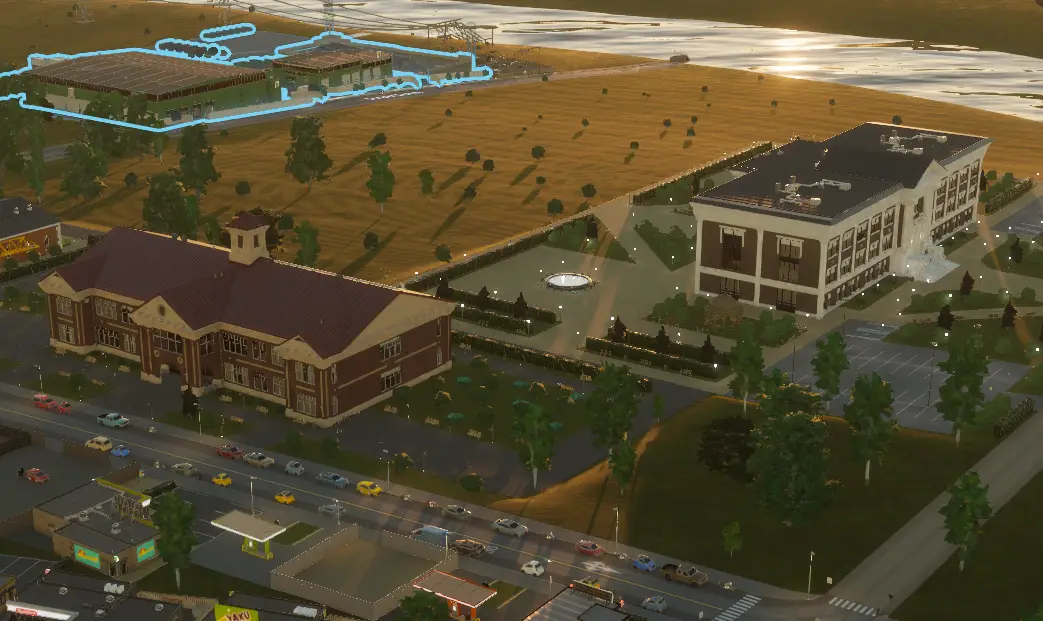
Better educated Cims work in more expensive jobs
The highest paying jobs require the most education, this is simple enough you probably knew this already.
Students often desire denser housing
Dense housing means more people in your city for less space, more people you can cram into high density housing means more taxes! More consumption! More economy! Growth! Growth! Growth!
Better educated Cims use less city services
Cims that are better educated create less garbage, pollute less, cause less crime*, cause less car accidents, stay healthier and therefore use less of your precious, expensive city services.
*By causing less crimes I mean that because their job prospects are a greater range and are more likely to get hired are less likely to become criminals
There are many other reasons but essentially better educated generally means better cims.
Place Primary School and High School facilities
These you should always have an excess of, always room for more students, this will make sure the vast majority of jobs in your city is available to the vast majority of people, your economy can therefore be an open and robust system that people and companies can operate in relatively freely.
Also make sure every High School has a Library upgrade in it, it’s a small cost that will make it easier for students to graduate. Yes dropouts are a thing and you want as few of them as possible. Think of it as a more secure investment, you are spending all of this money educating kids, if they fail that is wasted money. You want to make sure your money is well spent on successes, not failures.

Another good upgrade is for the Primary School, a playground improves the wellbeing around the school so it’s a lot more cost-effective than you’d think! To me, Paradox is saying that watching children playing at a playground is good for you…

Finally we come to…
THE EXCEPTION TO THE RULE
College and University, you should not try to meet demand with these, College and University are privileged positions, meant for the rich. You always want them full, never with a spare room available. You also don’t want too many people that educated, they’ll mostly be a waste of money and time spent studying and your own tax dollars. Highly educated positions are rare, take the village right now:

In this village, it’s essential to note that less than 5% of all jobs require a college education, with the vast majority at best requiring high school education. To manage your workforce effectively, you can use a tool to check on your open job positions as you expand your city. When you start facing significant issues with higher education job vacancies regularly, it’s a sign that you need to expand your college and university space.
Keep in mind the education levels:
- “Well Educated” typically requires a college.
- “Highly Educated” usually calls for a university.
There are four tiers of education, and it’s generally not efficient to have a Cim go through all four tiers just to end up working at a lower-skilled job, such as at a fast-food drive-thru. لذا, ensuring a balanced educational system in your city is crucial to meet the specific workforce needs of each job type.
Sneaky Resource Scouting
We won’t get the ability to hoover up these resources yet, so we can’t even see them yet, but we can actually see it on the map and plan for it.
This might get patched out but you can essentially see from Milestone 1 where any resource on the may roughly is by opening up the land permit tab and clicking on tiles like so:
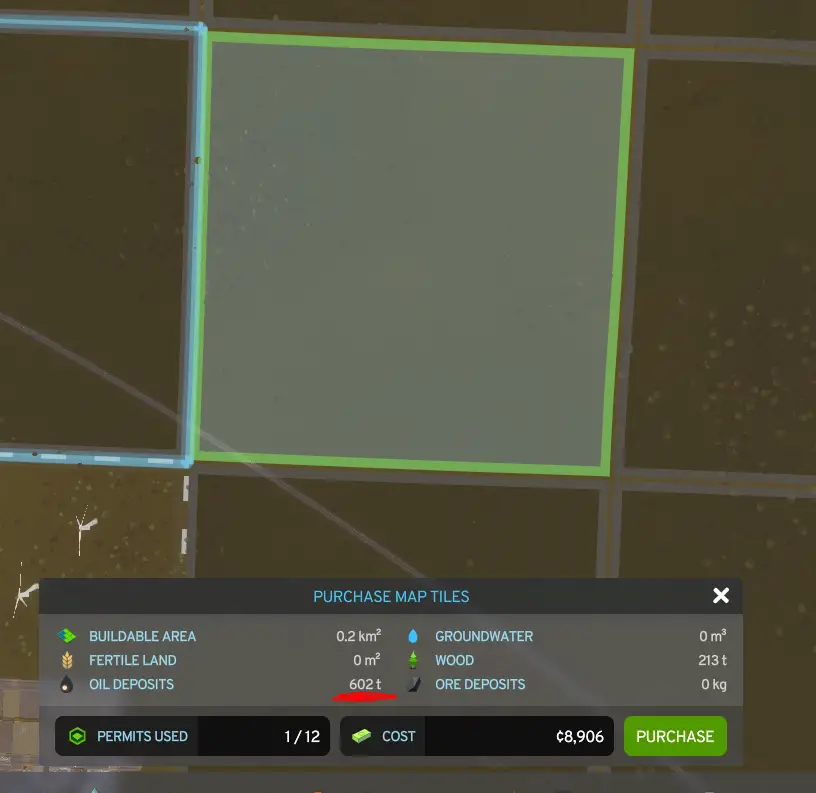
I bring this up now because we’ll soon need to plan our first resources out. Milestone 3 is up next and we want to know where we’ll want to build around.
The most important resource is fertile land, it is the least abundant, and because of grain’s superiority, we want as much of it exploited for farming as possible. So find the fertile land, and start planning around using it all.
I found a nice patch of it out to the West of my town which I’ll soon be able to reach, so my plans for expansion westwards for the time being has been made clear.
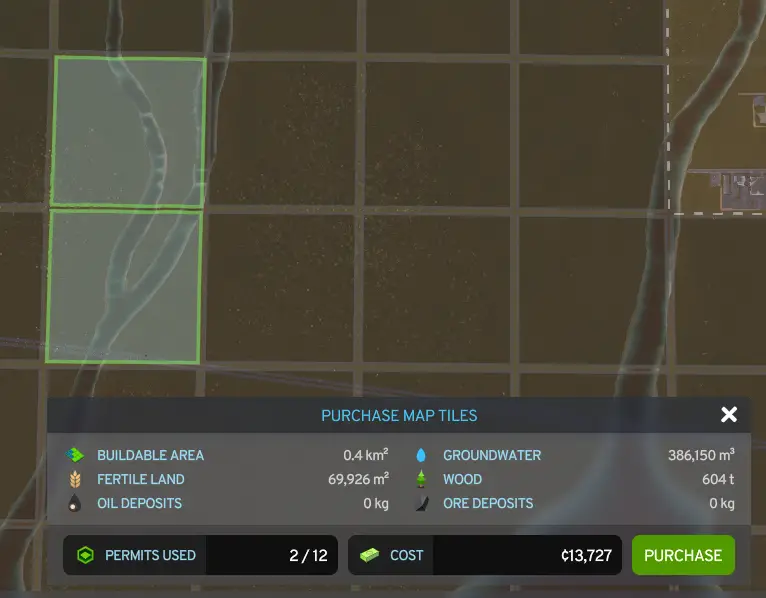
Even if you don’t want to use this, you’ll also not want to expand until Milestone 3, you’ll get the resources tab then and you’ll be able to see where things are exactly.
Milestone 3 – Setting up for the big industries
Milestone 3 is a very transitional point in time, you should only spend 1 dev point on getting the college just for the future. You don’t even need to spend it now but it’s better you spend it now and not need to do it desperately later.


One thing you should do is have a fire station, burning buildings don’t make money, you’ll always want to have fire safety covered because naturally they lower fire chances of occurring. Collapsing and burning buildings are going to ruin your economy since fire can spread very fast without an adequate response.

This section will cover the following:
- Planning around resources
- Livestock Farming
- Stone Mining
- Law and Order
By the end of this Section we’ll start making money and we’ll shouldn’t ever run into a prolonged deficit from this point on!
Planning around resources
Resources are the foundation of your city’s prosperity, and they are paramount in generating revenue. While the state doesn’t own the means of production, it collaborates with capitalists who do. Resources are the primary moneymakers in the game, and this becomes clear when you remember a fundamental principle: you are the state, not the company.
Industrial businesses, although they don’t generate the most profit individually, are central to your city’s development. Why focus on developing industries? It’s because industrial businesses are part of a massive logistics chain. At every stage of this chain, we can impose taxes. From taxing the raw resources to the refining of those resources into steel, and then the fabrication of steel into cars, and finally the sale of cars to consumers, we can tax each step of the process. Commercial taxes come at the end, but as the state, we can tax every single part of the production process, making industries a significant source of revenue.
Check your surroundings
Earlier we didn’t have access to this and I actually missed that we have fertile land really close by. But we’ve got a problem, a tiny issue involving my placement of the recycling centre. And thankfully because the game has been paused a lot it shouldn’t have polluted the ground too much.
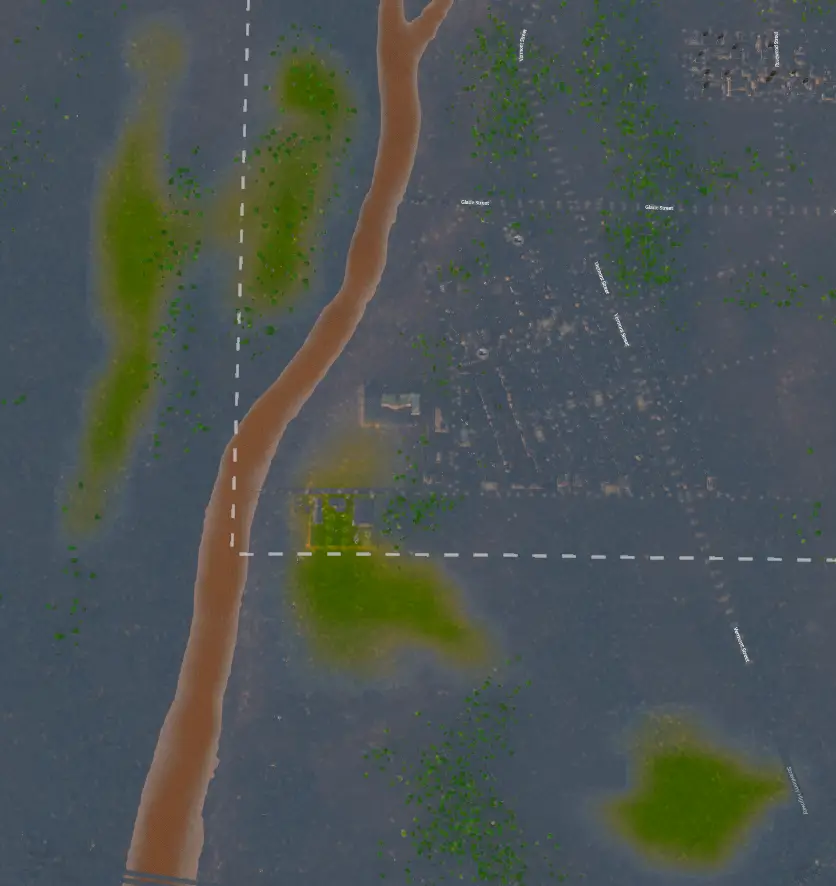
So I quickly moved it out of the way to the north of the town where currently, nothing is.

We haven’t yet unlocked grain farming so for now we’ll just have to plan around it and expand our borders slightly for it, like so:
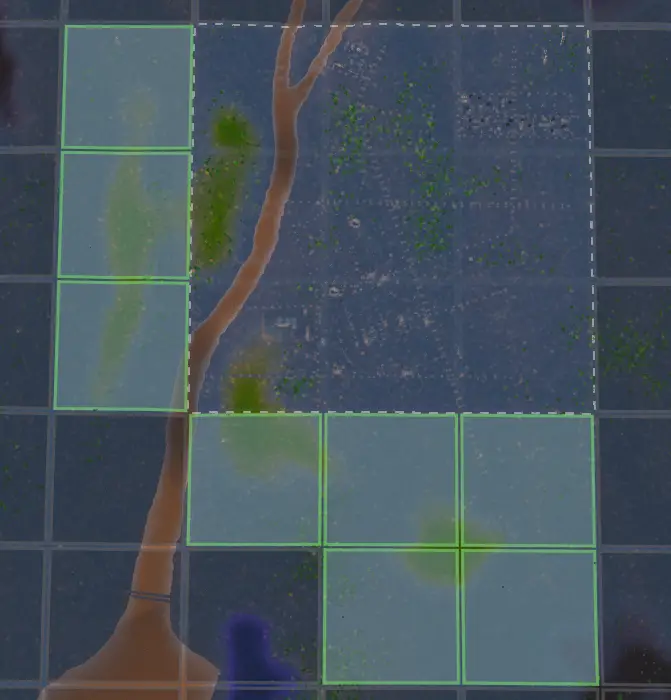
I had to move the High School, Power Transformer and High Capacity power lines away and made sure to bury those lines so they won’t be an issue again.
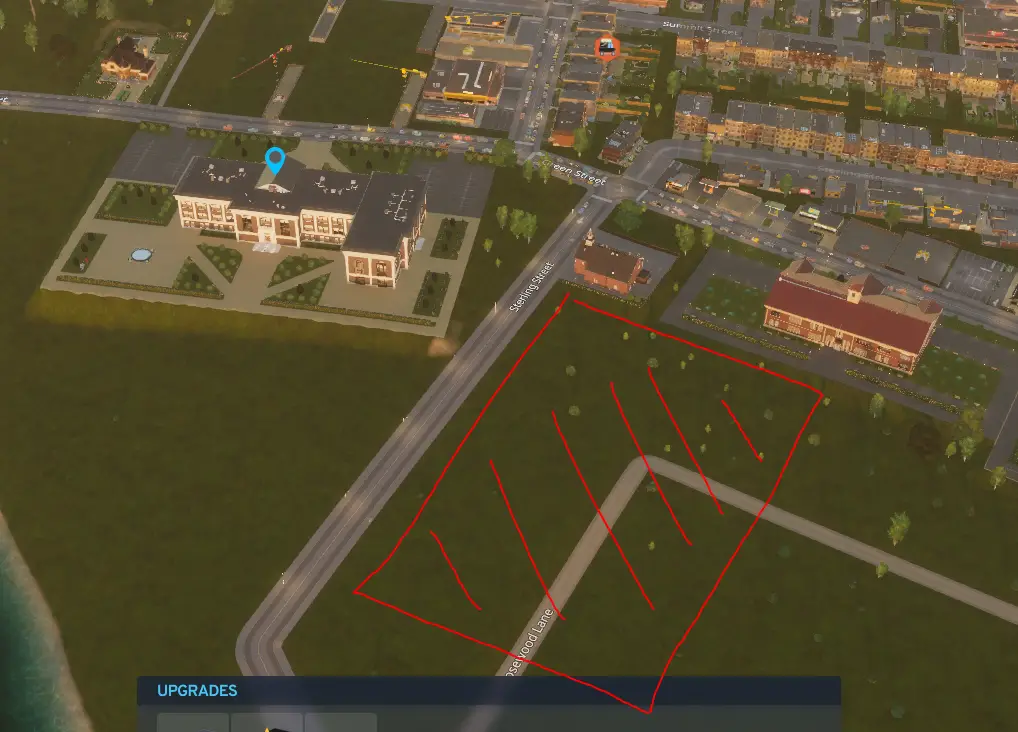
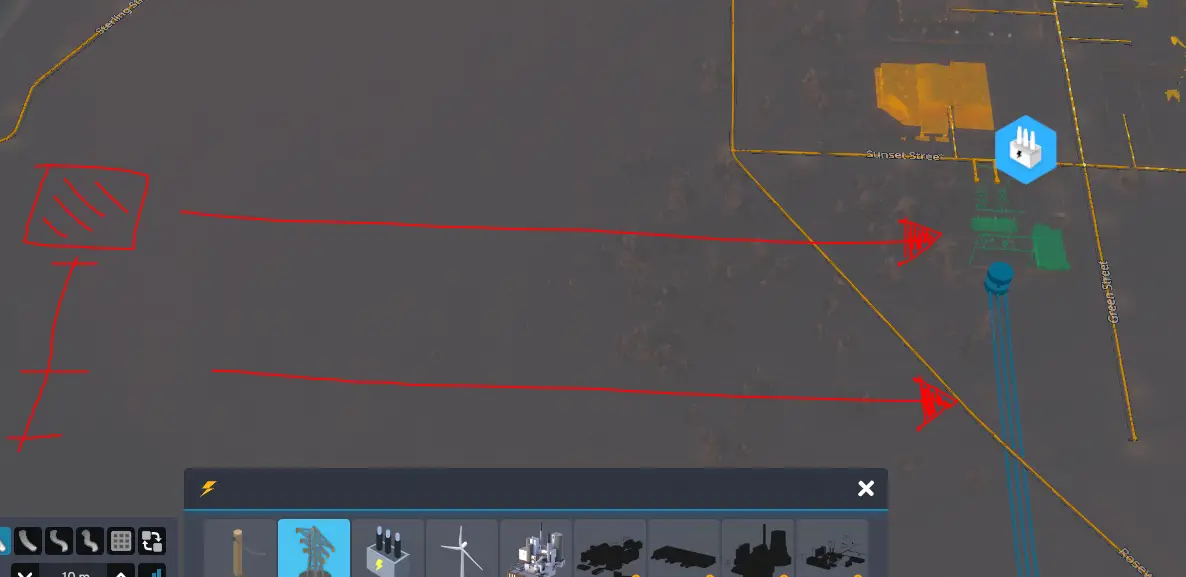
I made sure to then mark out the area with gravel so I don’t forget about it.
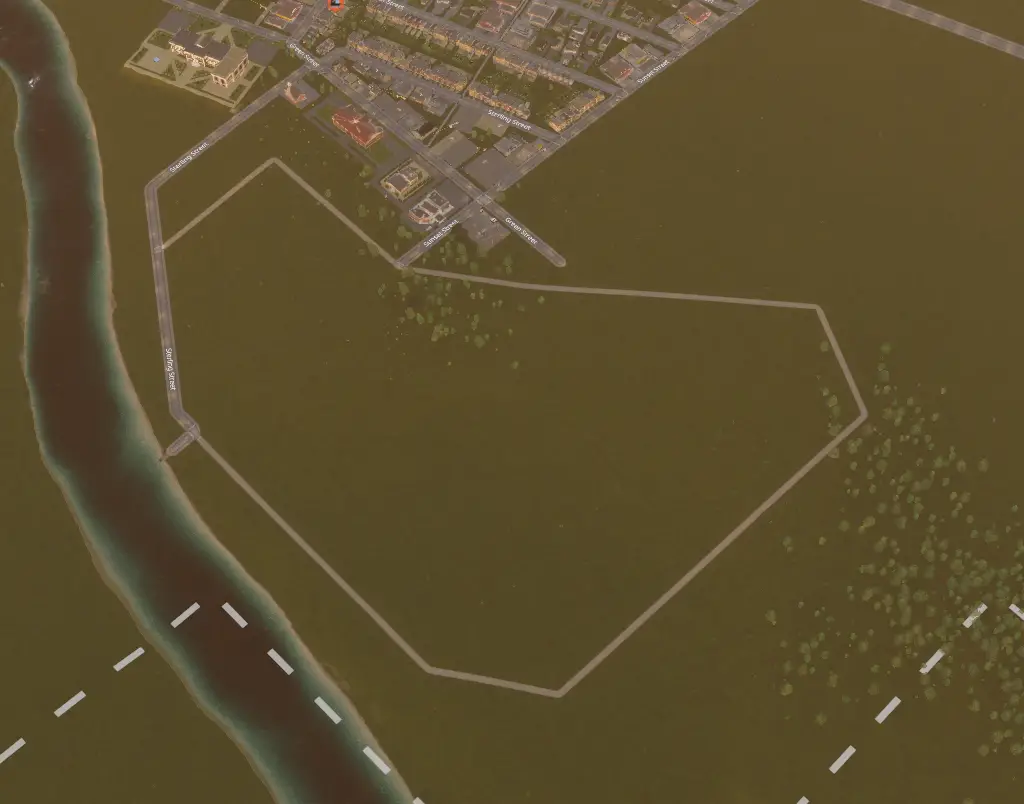
The other two pockets I didn’t mark with gravel roads since the one to the South is too far away to worry about now and the other is across the river, I know that now and will not expand across the river until I get farming up and running.
Livestock Farming
Livestock farming is different to all other kinds of farms: هو - هي DOES NOT require fertile land. لذا DON’T USE fertile land.
Instead place it close to other planned industries, because eventually we’ll be planning for more efficient cargo transport for those industries we might as well tack on this industry to boost their profits too.
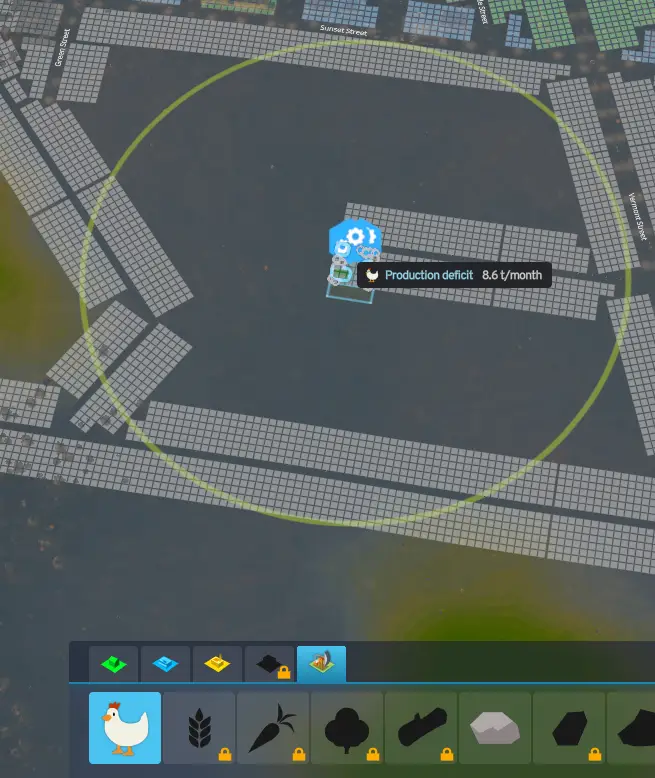
First determine a rough area you want to occupy that has no resources on it, close to other resources like the above image, and place the building. Immediately hit Escape, as far as I know, all industry zoning is bugged if you don’t do this.
Instead use this tool in the below image, this seems to always work for me.
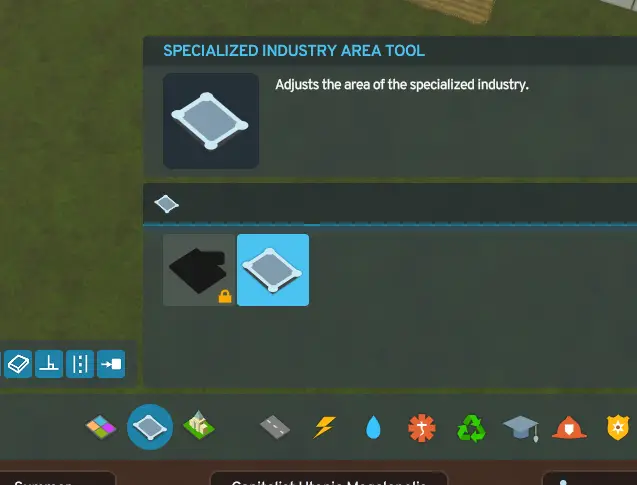
Another tip, when zoning, using roads and in most circumstances you can bring up the resource view like the below image:

First start using the tool in this case I’m using the zoning tool then select the ” أنا ” in the top left for info views, and select resources, you can get really close to resources without actually using the land designated for them like I’m doing in the above image.
Also if you’re struggling with getting your zoning to be perfect, turn off all snapping by hitting the Asterix symbol shown below:

But for roads, you want snapping on, it’ll help push your farm zone right up to the road using the most space possible. You should end up with something a little like the below image:
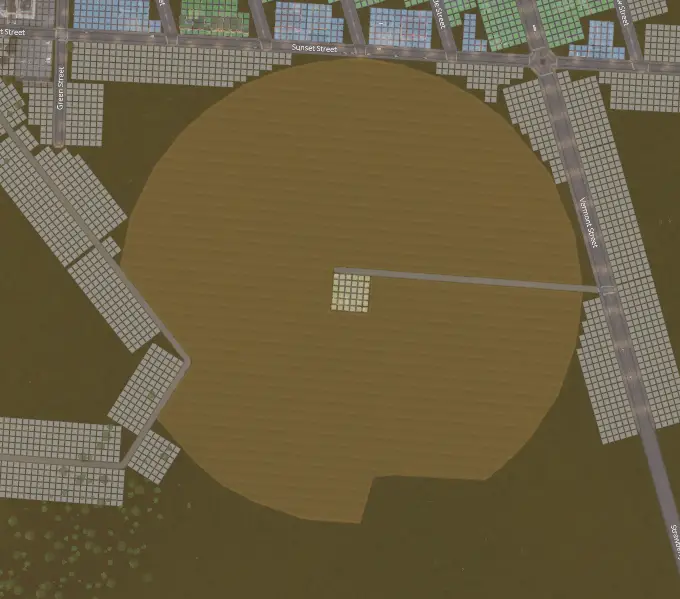
We can also, through expanding start to see a better plan and picture of our future city form:

In the above image we have a very detailed industrial plan laid out for us, three nearby fertile lands for farming, minerals as well. I have marked resource extraction points in red with “صخر” labelled in between the fertile land and minerals. The black central area surrounded by all of them will be an industrial area, all of the industries there will have access to all of those resources literally next door. To the south we have the perfect opportunity to make a cargo harbour for exports, we’ll also want a train station in the south too for setting up internal cargo routes but that will come much later. For now we’ve got our first plan to strive for.
Rock Mining
Following on from the Livestock Farming we’ve already determined the location of our rock mining project, and we’ve expanded our borders in line with the future plan to make a resource rich industrial working machine.

And due to the plans and developments of this industrial area I’ve had to make changes, even when you’re just starting out DON’T BE AFRAID TO DEMOLISH AND REBUILD. See below how I’ve reoriented the road to the future site of the industrial area. But my next consideration is that highway, that will be cutting my rock industry in half (see below):
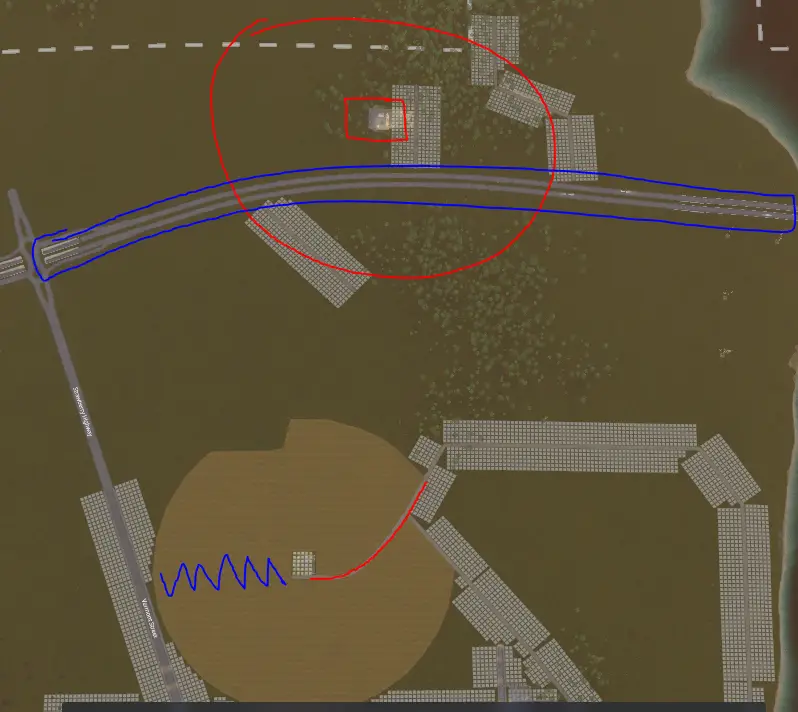
You’ve made a practical decision regarding your industry. Since you don’t have the available space to accommodate the entire area that the rock industry wants to occupy, it’s sensible to start with a smaller initial industry. بالإضافة إلى ذلك, you don’t have highways unlocked yet, so you’ll need to revisit this later when you can expand more efficiently. The key is that you already have a plan for your industry, and if you encounter issues like this, there’s no need to fret about fixing them immediately. These challenges can be addressed later, and they won’t hinder your ability to make money now.
Considering that your industry is not optimal at this stage and will be improved later, the proximity to the highway is a positive aspect. It provides easy access for the mines, streamlining transportation and keeping traffic away from your village, which is a strategic move.
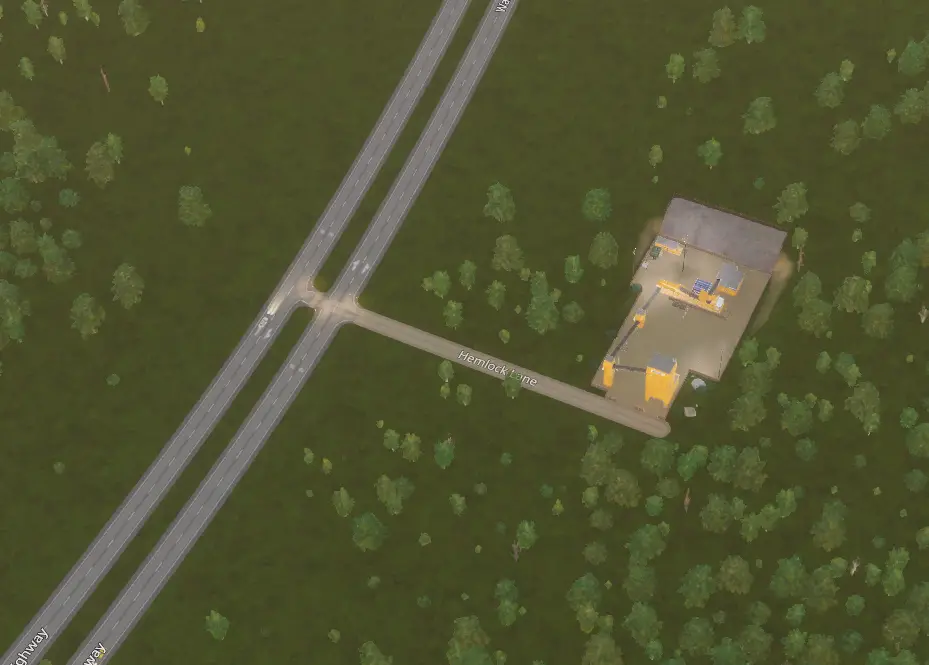
Also we’re using gravel roads for these industries, since they’ll only connect one business we don’t expect much traffic here, we can upgrade industrial roads to proper asphalt, but these resources are best left as gravel roads, especially now when cost cutting is very important to financial stability.
And thus we get a hodgepodge looking resource extractor for now but its potential is great for the future:
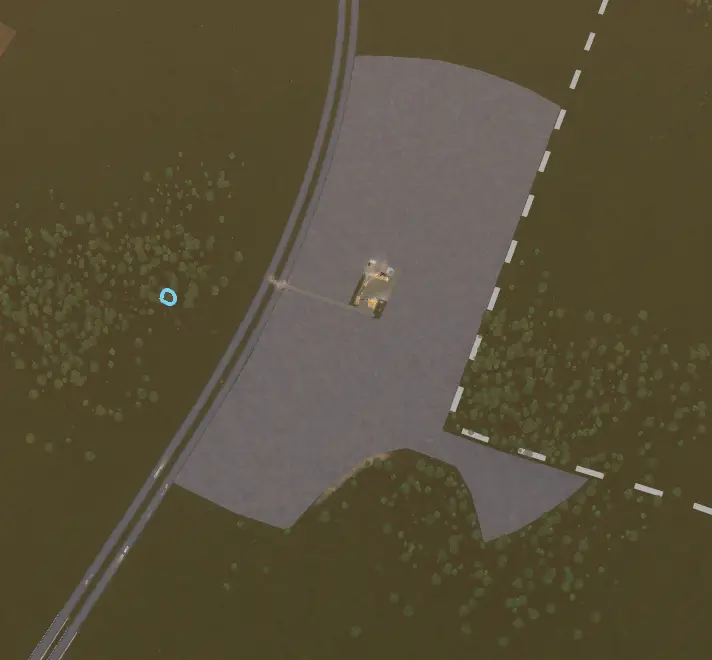
With these two industries set up, we can now let the simulation start running while we do the next step…
Brief Expansion Intermission
For this stage, you’ll probably need to expand a bit first, wait until you start running a profit. Personally I’m also only expanding my industry into the planned area and dezoning the old industrial area:

Also when de-zoning Industrial areas, check for ground pollution, it sticks around and will need to be cleaned up first before you zone anything else, especially Residential:

And always don’t forget to check taxation and your economic health, you’ll need to check it a lot in the early days of building your city, once your economy levels out it’ll be a much less tedious task.
For instance during my expansions and growth I changed my taxes like so:
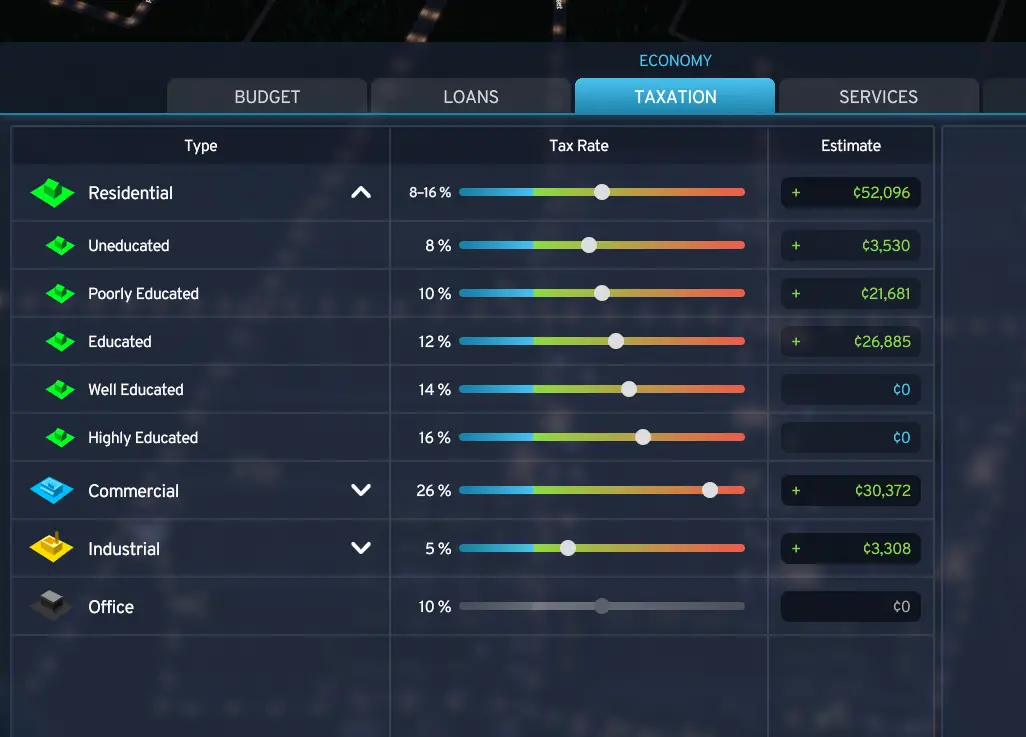
Before you start making profit you’ll likely hit Milestone 4, once you’ve started making a profit or you’ve got that sweet $1M from Milestone 4 you can move on to 5E: Law and Order
More than likely you won’t see profits, even though you definitely have the potential to reach profits now. You’ll likely be fluctuating up and down between profits and deficits, we won’t see stable profits for a while.
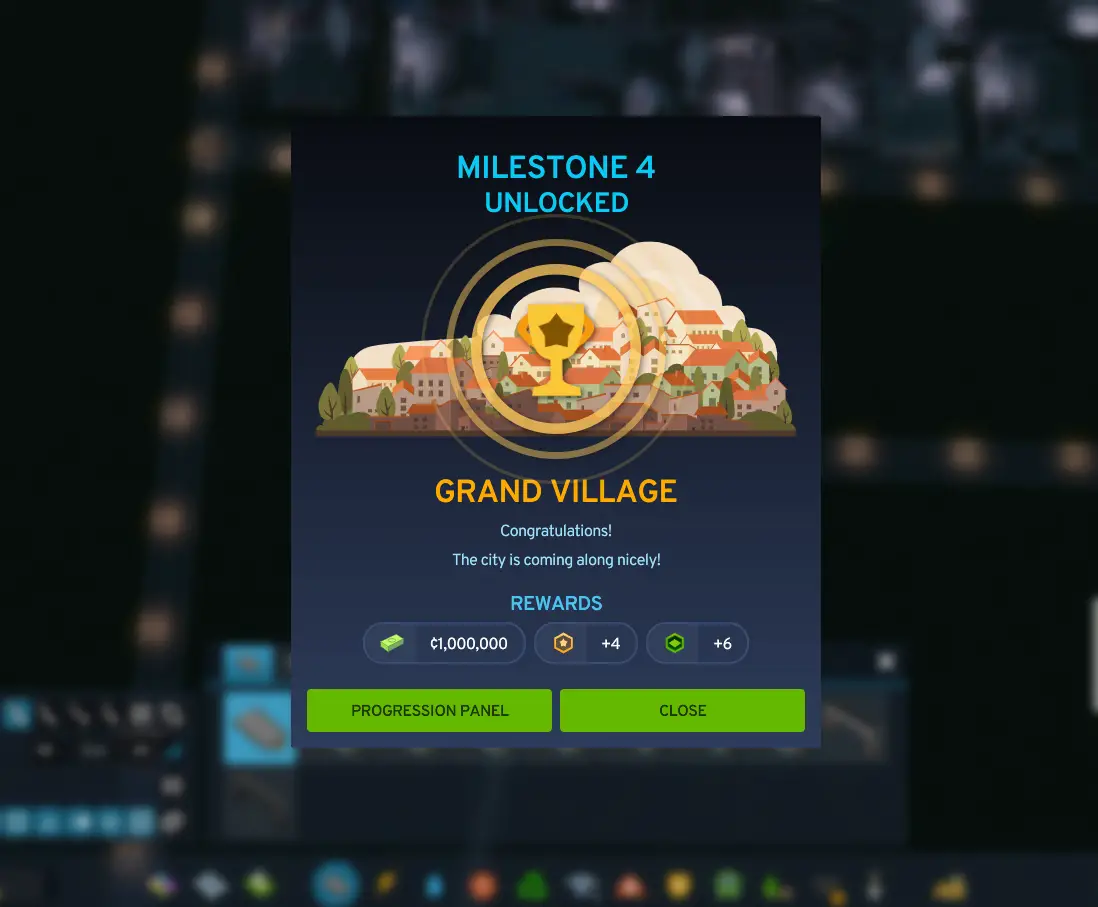
Law and Order
We unlocked police in this stage, but now we’ve got the money and funds to back up having police in our village. So go ahead and place a police station, this will help keep our economy operating without incident much like the fire station. But at least with crimes, money that criminals might have made will come back to us through the criminals eventual consumption of goods, people getting robbed don’t matter too much in the short term, but we don’t want this to be an epidemic.
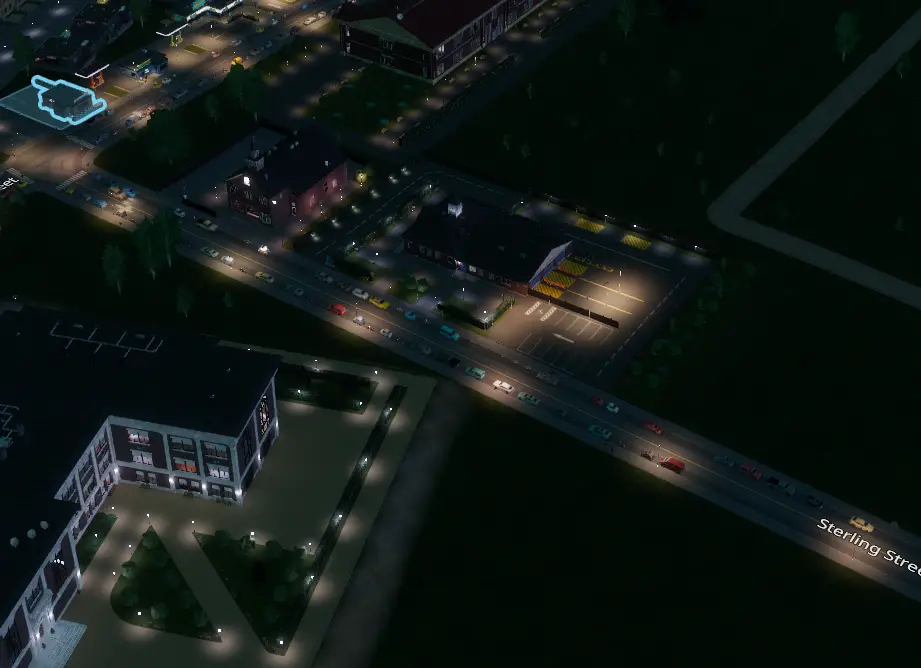
You’ll see that you have a stat for crimes committed per month and how many criminals you have, there is also a “probability” for crimes, which is not described well:

“The average likelihood of a building becoming a target for criminal activity” does not mean, “each building is this likely to be a target of a crime”. It means more along the lines of “Likelihood that this building will be robbed in this month”. Criminals also can only commit one or no crimes a month, I’ve never seen crimes occur more than the amount of criminals present.
Take my current private save:

These stats would normally ring alarm bells, 88%!!! That’s an insane rate, and an over 50% crime rate? Sounds like crime does pay in this city. نعم, it does… It pays me:

Like I’ve alluded to before, producing goods and criminals don’t really matter all that much as long as we make money from it all. And criminals still need to eat and pay rent, so despite the crazy crime rates, I’m still making literally $2M a month on this save… And when I took those screenshots I was in the process of building a ghost city:
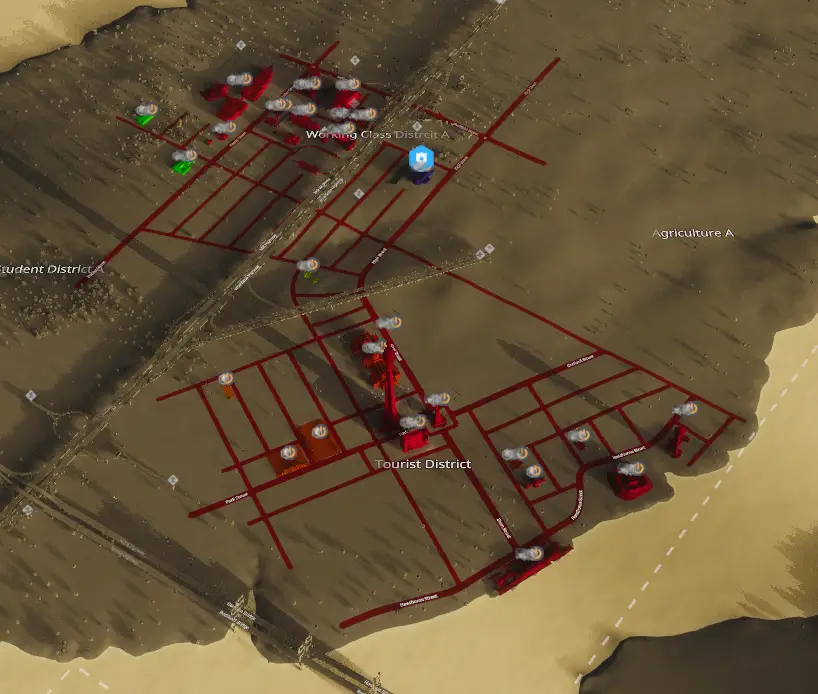
So yes, this city was making fat stacks of cash despite the crime rate. Sounds like New York…
So don’t worry too much about crime affecting your economy, so why bother with it? Rich businesses and people still need police, without them we have no economy, so we can protect the rich neighbourhoods and businesses. If we happen to protect the poor as well then oh well, you can make your police force beat your crime rate but criminals are not a plague on your economy. Which is a lot more realistic than you might think it is.
If you’re getting seriously big effects from bad crime, obviously fix it, but if your citizens are happy, who cares how many criminals are running around?
Milestone 4 – Building for the future
With your forth Milestone, these dev points are going to be spent on getting Geothermal energy and Highways. I got highways because I need them to work on my Industrial area, but if you don’t think you need them yet, you can buy something else. The important part is geothermal energy, this is going to be very profitable!

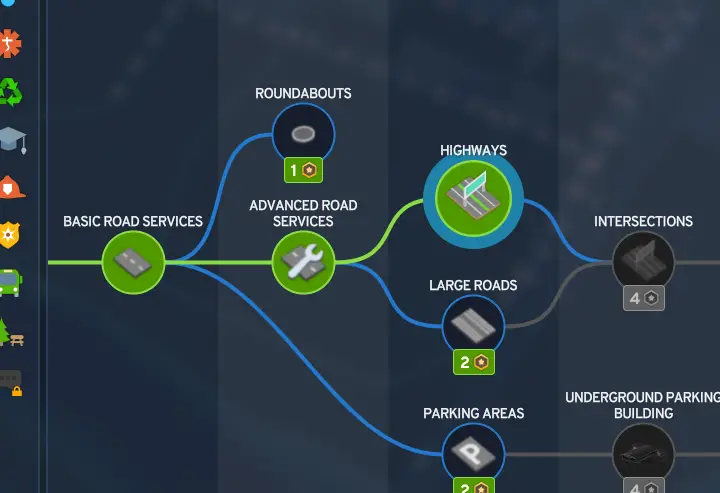
We’ll be exploring a few things this segment:
- Geothermal Power
- Recreation and Parks
- Offices
- ربح, Growth and Lower Taxes
- Grain Farming
- Resources/Production Monitoring
- Public Transport
Also a new tool we got is the district tool, this tool can also help with applying policies but you don’t need them with this guide to get anywhere. I usually use Districts to name suburbs and to plan out expansions:
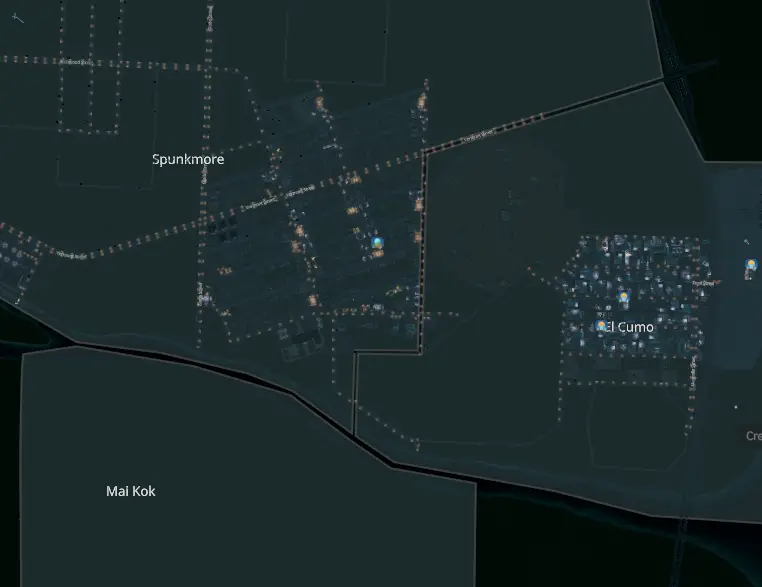
Geothermal Power
It’s important to consider the placement of your geothermal power plant, expand your borders if you need somewhere further away to do this. For me I’ve figured out four decent locations for me to put it in:

It’s important to note that Geothermal produces noise, ground and air pollution in decent amounts so it needs to be upwind from residential areas and away from them too.
This rules out all but one location, لكن, I’ve got a better plan to expand my borders and build one on this island here since it’s very far away from everything and only has a small resource node for ore which I won’t cover by doing this.

And make sure to hook it up with the power grid by a large power line, it’ll need that throughput to export all that power abroad.

At this point though you’re gonna be strapped for cash, there’s no shame in waiting for money to accumulate or to take a loan to speed through it, we’ll be moving on with other projects soon too.
Scotty Update 2: BIG NEWS
So checking in on Scotty once more, he’s posted that he moved house:
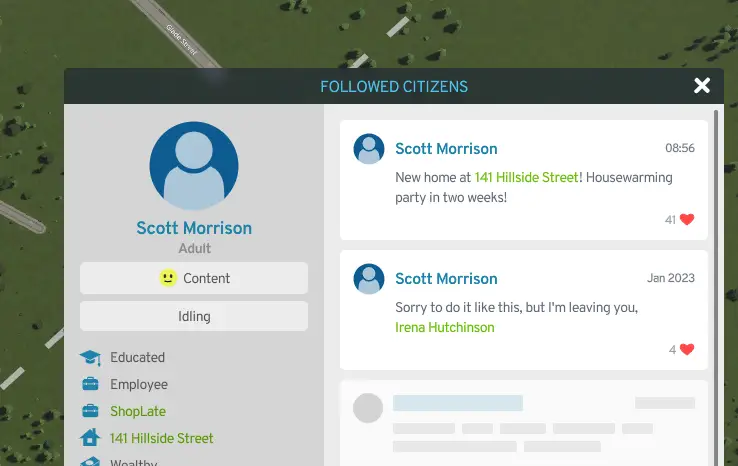
But that’s not the big news, far from it, I followed him home one night and saw him having a conversation in his front yard with a young teenage boy.

Turns out he adopted a teenage boy, wow, what a great guy this Scott Morrison is!

But I knew something was up, just like we all knew something was up at Engadine McDonalds, Scotty seemed clean, yet he stank… And that’s when it hit me, I’d seen that workplace before…
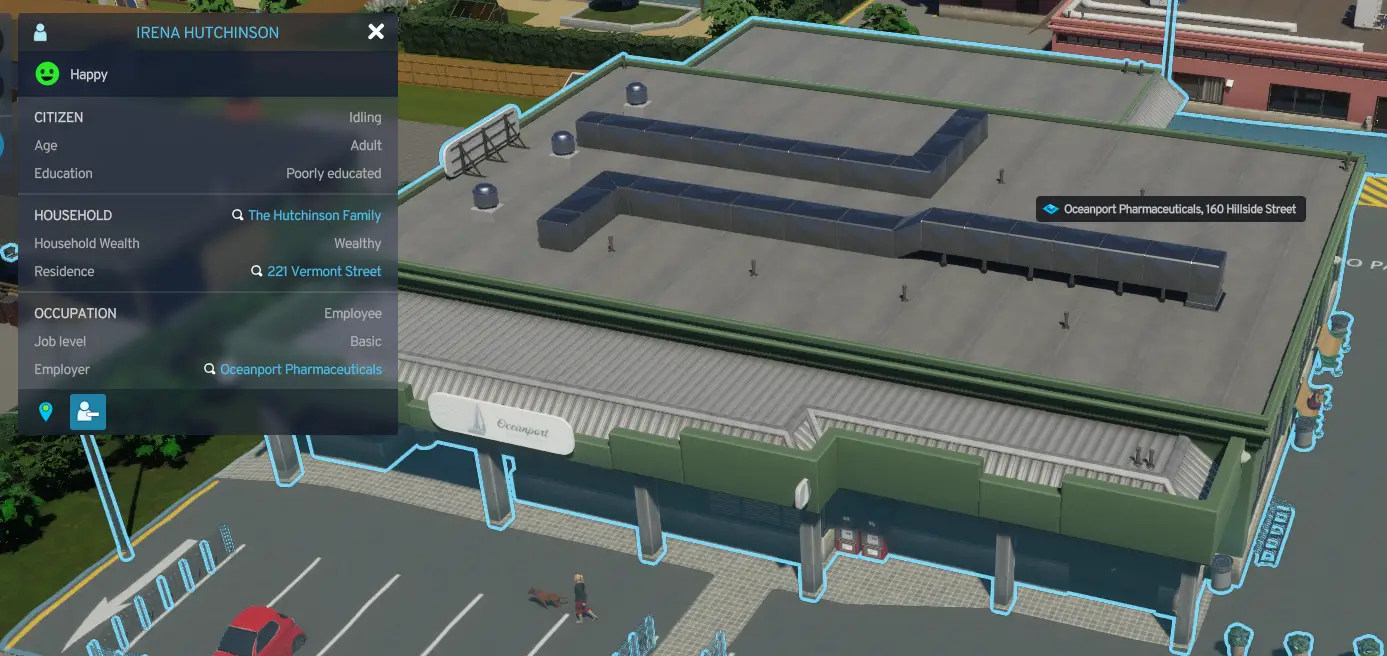
What do you know, Irena, Scott’s ex works at that very place. Scotty didn’t adopt a child in need, he hired an underage, undercover and probably underpaid spy!
At least I can be happy knowing that my city planning has been working since Brett’s commute to work is quite literally a stone’s throw away.
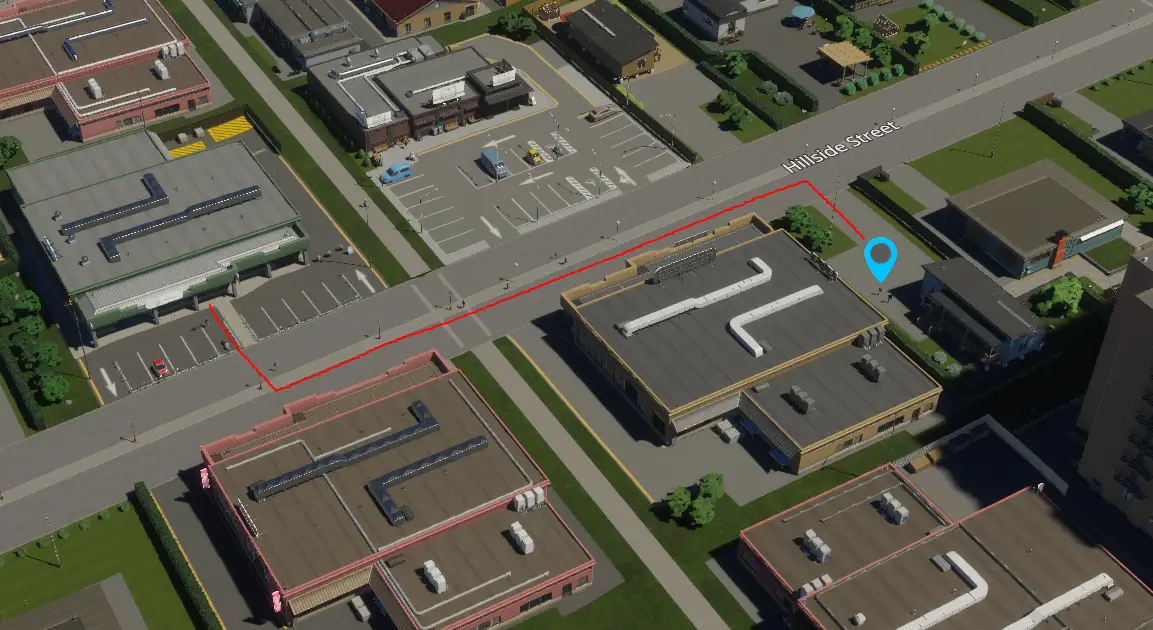
Parks and Recreation
Not the sitcom, but the act of building parks for the purposes of recreation, and other buildings for recreation.
Parks and Recreation are a cheap, easy way to raise land value (desire), happiness, wellbeing and eventually tax rates (not directly).
There’s never a reason to litter your residential areas with more parks and recreation. Cover all residential areas solid green:
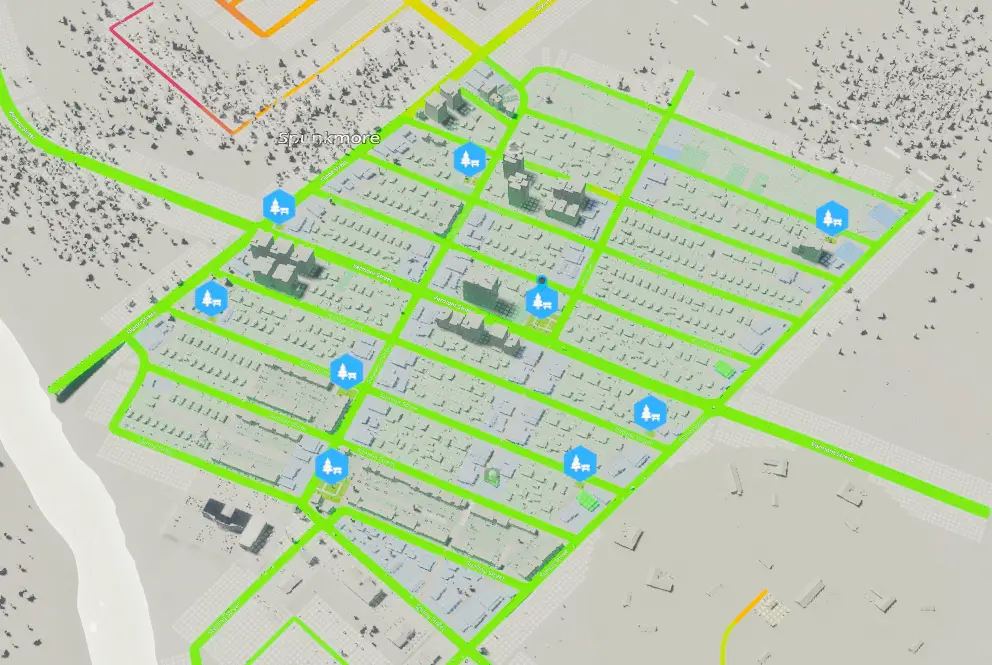
It’ll cost you almost nothing but time!
Offices
Offices are very different industries, they are a great buffer between low pollution zones and residential areas or in busy noisy areas. They require roads to be zoned unlike Residential and Commercial. So you’ll have to ditch pedestrian streets:

Offices produce “Immaterial Goods” (more on this later in the guide) and have a large draw from higher education employees. You won’t want a college right away but start checking the employment openings more frequently, this is where you need to start checking this tab more frequently:

The College holds 1000 students, when you get close to 1000 open positions in the Well Educated section, that’s when you need to place the College to accommodate for the demand.
Office profits are also far more sensitive to taxation changes as far as I know, even in larger cities with larger office industries they seem to be very sensitive to tax changes, likely because the companies who make these immaterial goods can just up and move on a whim to the next low-tax state. They do however make plenty of money compared to other industries and are a core part of the production chain, a necessary evil is to accommodate these picky capitalists for their productive forces:

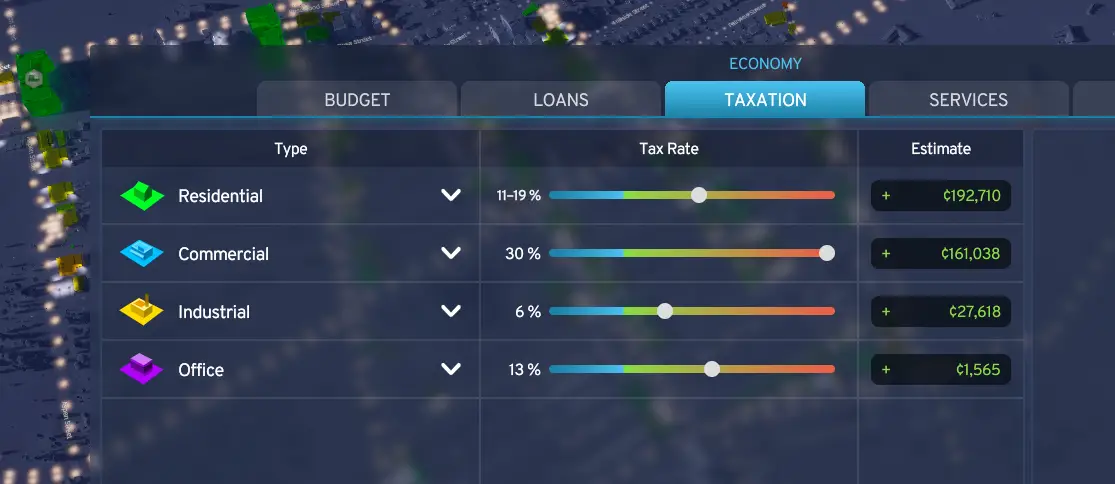
So they get special tax rules from me, roughly half their profit is taxed unlike most where they sit at two thirds taxed. But again, this isn’t a hard rule even the two thirds rule, experiment with taxes to try and make your businesses profitable.
We’re starting to get to the point where we’re settling in economically, profits should be very stable and consistent now, you should be reducing taxes now to build up economic growth and profits.
Growth, Profit and Lower Taxes
This tooltip says it all really:

The amount of money people have left over is put into their properties, levelling them up. This will give us money in the long run, and we can accomplish this by lower taxes to give people more disposable income. This also works for businesses.
We’re now going to be doing our taxation in reverse, for people it’s much easier to find their resting point.
We just click this tab here to create a “Vibe Census” of the city:
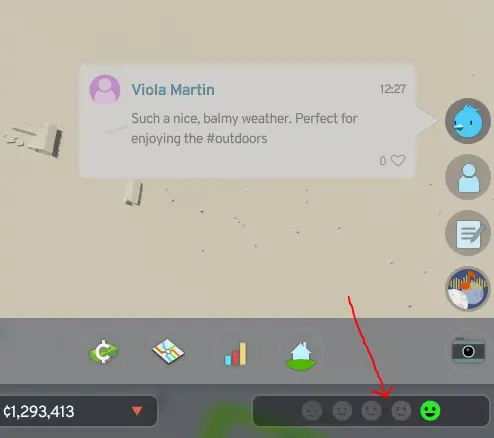
Which gives us this info:
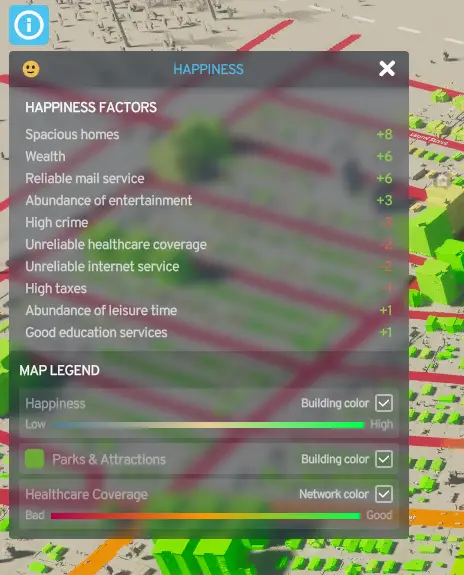
We can tax people as much as much as they stay happy and we don’t cause an exodus, this will change more as you provide more services to your people later.
With company profits you want to aim for 20% profit margins after taxing them, which for industry at this stage can be ignored, you’ll probably have to subsidise them to make it work.

This should make your economy set for a steady growth. Everything from here on will be making the biggest and most powerful profits you can.
Grain Farming
Grain is by far the most important resource in the game, but how and why?
Some reasons why are obvious:
People eat Food
نعم, mind boggling I know, but this is actually more nuanced in City Skylines, food is broken up into three consumables:
Beverages, Convenience Food and Food:
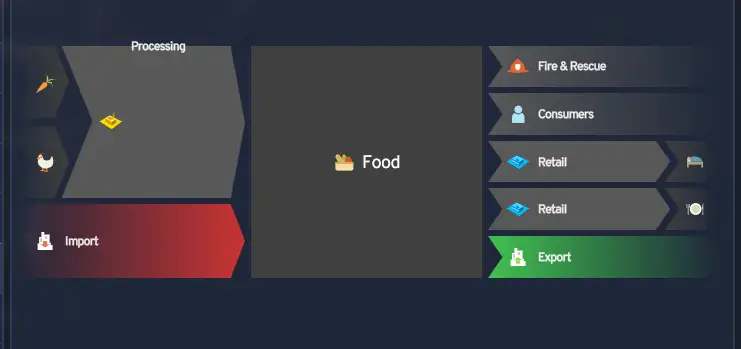
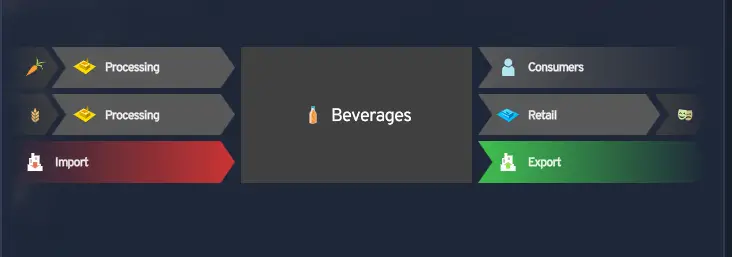

Looking at things this way, you’d assume Livestock, Vegetables and Grain are all equal under resources, but this isn’t true. There’s more to just these three products than meets the eye:
Not all food is equal
Convenience Food is by far the most demanded food as you can see in this resource tab here:
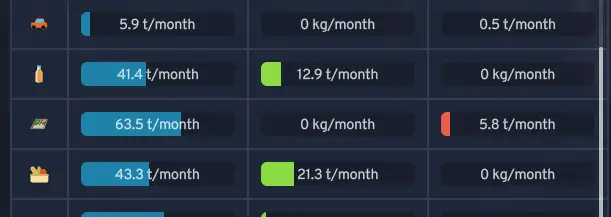
Food and Beverages are produced in excess (the green bar) meaning they are exported, but despite Convenience food being produced in greater quantities it does not satisfy internal consumption of the city. By far Convenience food is the most demanded food, لكن, convenience food also requires livestock, so aren’t they just two equal groups? لا, ولا حتى قريب…
Industrial bases
Livestock farming produces inputs for Food, Convenience Food and Clothes, the meats, eggs, milk and other produce make up the various foods and the hides and leathers make up clothes:

Clothes are the last stage of their own production line:

Grain also goes into petrochemicals, which goes into clothes as well, and also plastics, which also goes into vehicles and computers, which also allows software development, media production. Grain is the base for over half of immaterial goods in your city, and nearly half of all material goods. Second to it is Oil which is tied to a lot of the same processing lines, only difference is you can’t eat Oil.
I shouldn’t need to explain it, but place grain farms, always have an excess of grain (and oil but we’ll get to that later, it’ll be unlocked at Milestone 8) it is the most critical resource in your city.
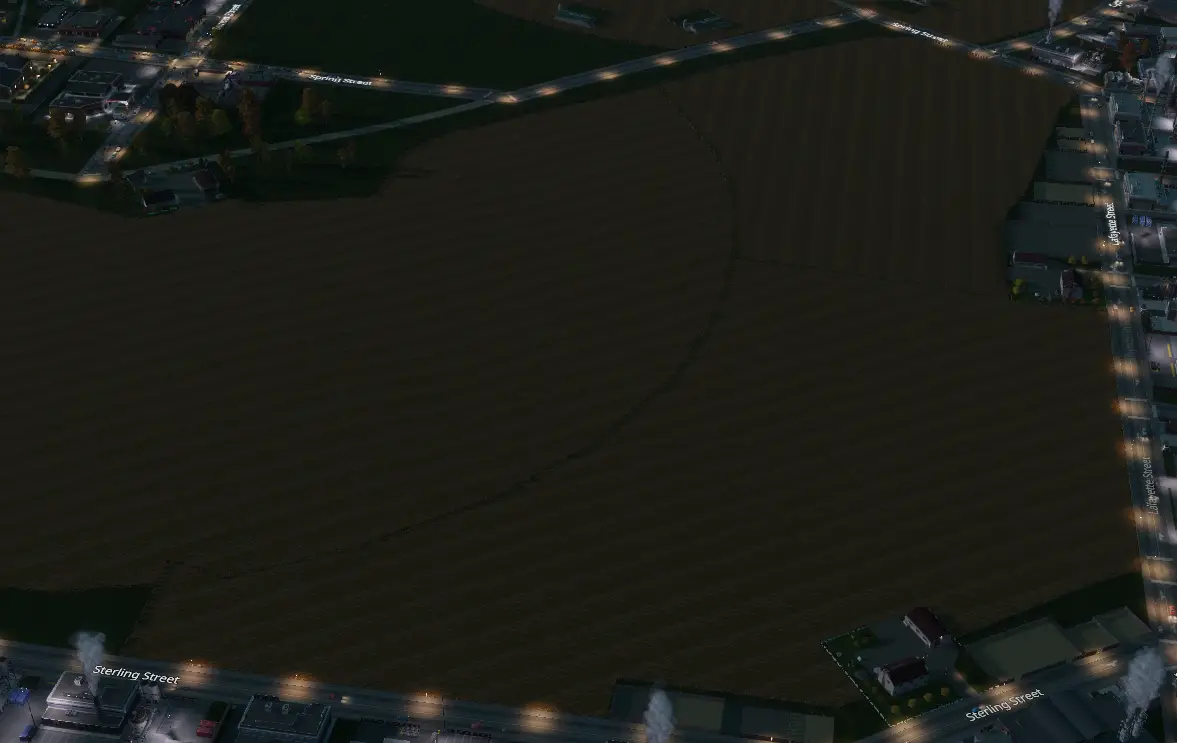

So with an excess of grain, be sure to check your industrial company profits and taxation soon, you’ll probably want to adjust it to configure it for growth now but keep an eye on it and lower taxation if you start seeing industrial profits dropping. But start taxing them so you can make money too!
Resources/Production
As a filthy, degenerate capitalist economy, we want to make the most money possible and we want our capitalist to make as much money as possible. We must partake in the commodity obfuscation method of production, or in other words; develop the inefficiency of the capitalist mode of production for the means of profit.
We make tax money by the most complicated parts of our production chain, because at each step of production we get a cut of taxes. We can use this understanding to develop our next resources and decide what we want to work towards next:
Cotton
Is useless, it only has one step in the chain, better to import it than waste fertile land on it in almost every case.
Vegetables
Just get made into beverages and food, useless, only slightly better than cotton, better to import it than waste our fertile land on it.
زيت
We would love to use Oil, since it is extremely complicated but we’ll have to wait until Milestone 8 for that.
الفحم
Goes into steel which goes into machinery which is then consumed by industry, a small chain but steel also has metal inputs, metal ores.
Metal Ores
Develop metal which becomes steel, سيارات, and machinery, steel goes back into machinery. So Metal Ores is more complicated it is more important to develop. But we also can’t use this yet until Milestone 7.
This is the fundamental way to understand production and resources, how complicated is its chain of production? The greater its complexity the more worthwhile it is to develop it. The three outliers are Wood, Livestock and Rock, all of which are supplementary and don’t use resources on the map and are essentially “التعزيز”.
For Grain, معدن, زيت, خشب, Livestock and Rock (بهذا الترتيب) should be kept in a positive balance. The only reason we haven’t touched on wood is because it is unlocked after Rock and Livestock.
Here’s the current state of our Capitalist Utopia Megalopolis’ production of resources:
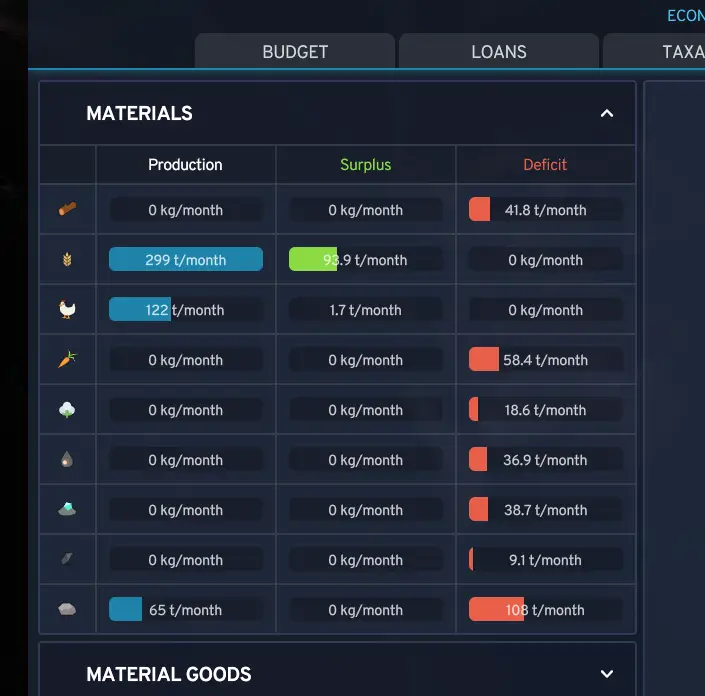
It’s not perfect but we can’t make it perfect until later when we unlock Oil and Metal Ore anyways I’ll also be zoning a forestry area but it is exactly the same as Livestock and Rock Mining, just zone it where no resources are near you industrial area.
Public Transport
I won’t go into too much detail with Public Transport, it is a great way to cheaply and efficiently move Cims around your city. If you’ve followed this guide so far then most of your public transport should be getting people to and from work. Especially in the cases of some of your resource industries where getting people to work:

Public Transport is not a business, you might be able to make a profit off it, but you’re far better off making it free just to move the most amount of people around as possible.

There’s a lot that goes into making public transport effective like how far away you should place stops, where you should place them, how to configure them, how many buses. But approach it with the idea of moving people from their homes to their jobs first. And if its for tourists from their arrivals to their hotels and from their hotels to the landmarks.
Conclusion and Further Recommendations
I want to keep this guide brief enough, you should be making steady profits now and building this city alongside the recommendations and outlines in this guide here is where I’m sitting now:

A very healthy, stable and growing economy that is profitable. I’ve got so many dev points spare, nearly $5M in the bank, from here there’s much more room to expand my profits and build my economy.
I could do with making my people a little happier but honestly they’re making me money so I don’t care about them.
I’ll do some quickfire recommendations on how to build your economy from here:
Train/Ship Cargo
You can fund and build up train or naval cargo routes to make your industries more profitable and therefore tax them more to make more money!

Oil and Metal Mining
As I mentioned earlier, this is where a lot of money will come out of for industrial profits, so build into those industries as well!
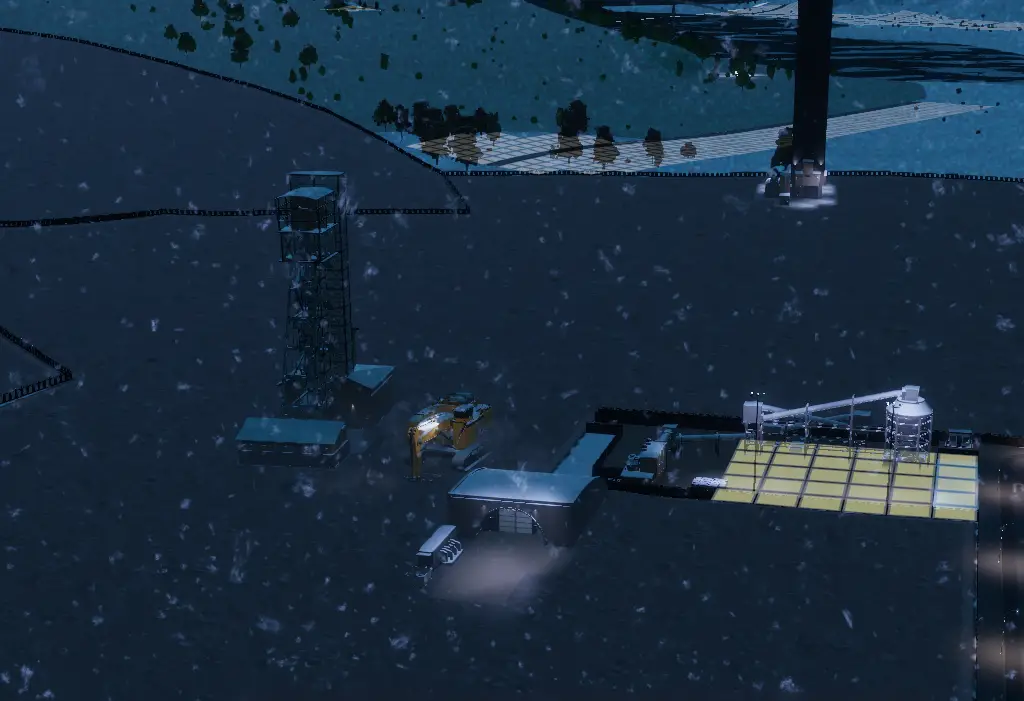
Internet services
Always give your citizens and businesses reliable internet, it boosts productivity and happiness, giving you more room to tax them!
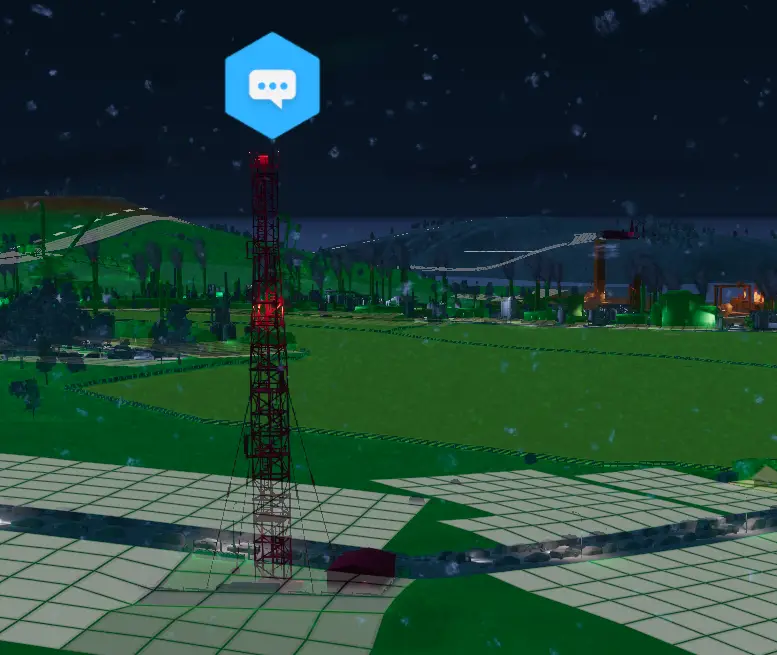
Good luck with your cities and if you have any burning questions feel free to ask me and I’ll try to answer them!
هذا كل ما نشاركه اليوم من أجل هذا Cities: Skylines II مرشد. تم إنشاء هذا الدليل وكتابته في الأصل بواسطة Ion95. في حالة فشلنا في تحديث هذا الدليل, يمكنك العثور على آخر تحديث باتباع هذا وصلة.
